Hampi
(→The temple town) |
|||
| Line 16: | Line 16: | ||
Village in Bellary District, Madras. Site of Vijavanagar. | Village in Bellary District, Madras. Site of Vijavanagar. | ||
| + | |||
| + | ==10 Less Known Facts about Hampi== | ||
| + | [https://www.karnataka.com/hampi/10-less-known-facts-hampi/ APRIL 20, 2017 BY MADUR: ''Karnataka.com''] | ||
| + | |||
| + | |||
| + | Hampi is the town of ruins of Vijayanagara Empire. It is one of the UNESCO recognized world heritage sites in India. The place is one of India’s most known archaeological destinations. The town of Hampi is in a secluded area, with royal residences, temples, towers, roads, and statues, all spread over a massive area. The heritage site is located near the River Tungabhadra. The famous tourist destination never fails to attract travelers all around the world throughout the year. Here are a few less known facts about Hampi. These facts about Hampi are enough to make you plan a visit to this incredible place. | ||
| + | |||
| + | [[File: Stone Chariot, Vittala Temple, Hampi, facts about Hampi.jpg|Stone Chariot, Vittala Temple, Hampi, facts about Hampi <br/> From: [https://www.karnataka.com/hampi/10-less-known-facts-hampi/ APRIL 20, 2017 BY MADUR: ''Karnataka.com'']|frame|500px]] | ||
| + | |||
| + | |||
| + | '''1. Musical pillars''' | ||
| + | |||
| + | A standout amongst the most appealing structures is the Vittala Temple. This antiquated temple is famous for its marvelous architecture. It is also known for another extraordinary architectural marvel- 56 melodic columns or the musical pillars. These pillars create melodic sounds when tapped delicately. The most intriguing thing is that the columns are constructed using stones. The melodic mainstays of Vittala Temple are also called SAREGAMA pillars. | ||
| + | |||
| + | [[File: Music Pillars. Image courtesy Vinayak Kulkarni.jpg|Music Pillars. Image courtesy Vinayak Kulkarni <br/> From: [https://www.karnataka.com/hampi/10-less-known-facts-hampi/ APRIL 20, 2017 BY MADUR: ''Karnataka.com'']|frame|500px]] | ||
| + | |||
| + | |||
| + | '''2. Architect tactics of those times''' | ||
| + | |||
| + | Hampi is scattered with ruins of giant monuments of the Vijayanagar Empire which were built with granite rock stones existed in abundance in the town. There is an interesting tactic that the artists of those times followed to cut these gigantic stones and changed them into bits of art pieces in that old age. When a rock was cut, a sequence of holes was made on the stone’s surface. Then the dry wooden pieces were pegged into the stone. Water was poured over the pegs such that they are soaked well in it. As the wooden pegs are completely doused with the water, their size expands and the small pegs cause the stone to split and break apart due to the mounting pressure inside. | ||
| + | |||
| + | |||
| + | '''3. The name and the age of Hampi''' | ||
| + | |||
| + | There is a typical misguided judgment that Hampi was built up by the Vijayanagara Empire. Nonetheless, the primary historical record of settlement in Hampi goes back to 1st Century. Evidence shows that the district of Hampi was under the governor of Ashokan Kingdom amid the third century BC. | ||
| + | |||
| + | Hampi customarily known as Kishkinda-kshetra, Pampa-kshetra or Bhaskara-kshetra is obtained from Pampa, an old name of the River Tungabhadra. The city of Hampi is located at the southern bank of this river. The name Hampi is an adaptive form of the Kannada Hampe (derived from Pampa). This is indeed an interesting fact about Hampi, isn’t it? | ||
| + | |||
| + | [[File: Bust of Krishnadevaraya’s queen at Archaeological Museum, Kamalapur, Hampi. Image courtesy- vkiran_2000.jpg|Bust of Krishnadevaraya’s queen at Archaeological Museum, Kamalapur, Hampi. Image courtesy- vkiran_2000 <br/> From: [https://www.karnataka.com/hampi/10-less-known-facts-hampi/ APRIL 20, 2017 BY MADUR: ''Karnataka.com'']|frame|500px]] | ||
| + | |||
| + | |||
| + | '''4. The Archaeological Museum''' | ||
| + | |||
| + | The Archaeological Museum in the town shows numerous things from the vestiges and ruins of the empire era. These incorporate many pictures of Durga, and furthermore the Lakshmi statue juxtaposed with the solid Narasimha of Vijayanagara. In the courtyard of the historical museum, there is a huge model of the whole town of Vijayanagar. Pictures and detailed history of early and ancient man in the area can likewise be found in it. Not the majority of guests know about this museum. It is situated close to the town of Hosapete within the ruins of the Vijayanagara Empire. | ||
| + | |||
| + | [[File: Hazara Rama Temple Outer Wall, Hampi. Image courtesy- Dinesh Kannambadi.jpg|Hazara Rama Temple Outer Wall, Hampi. Image courtesy- Dinesh Kannambadi <br/> From: [https://www.karnataka.com/hampi/10-less-known-facts-hampi/ APRIL 20, 2017 BY MADUR: ''Karnataka.com'']|frame|500px]] | ||
| + | |||
| + | |||
| + | '''5. Relics of Ramayana''' | ||
| + | |||
| + | Hampi is also famous for the Hazara Ram temple. The temple has gained popularity because of the presence of historical objects and fossils that are claimed to be present at the time of Ram and Krishna’s era. The entire outer walls of the temple are carved and ornamented with the antique objects that narrate the Ramayana, a holy book that delineate the life of Lord Rama. It is claimed that the fossils and antique objects that are present in this temple are the rarest ones found in whole India. We bet did not know this fact about Hampi. | ||
| + | |||
| + | |||
| + | '''6. Naughty baby elephant''' | ||
| + | |||
| + | On entering the second tower on the left side in the Virupaksha Temple; one would see the temple’s main detainee, a baby elephant. If given a one-rupee coin, the elephant will collect it with his trunk and will kiss on the head as a blessing. | ||
| + | |||
| + | [[File: Watch Tower at Hampi.jpg|Watch Tower at Hampi <br/> From: [https://www.karnataka.com/hampi/10-less-known-facts-hampi/ APRIL 20, 2017 BY MADUR: ''Karnataka.com'']|frame|500px]] | ||
| + | |||
| + | |||
| + | '''7. The inverted tower''' | ||
| + | |||
| + | There is a staircase behind the leading sanctum of the temple that heads towards the back exit of the temple. A dark chamber with a small opening in the wall is present before the exit on the right side. At the point when the sun beams go through the opening and fall on the western wall, the inverted main tower is visible as the shadow in the image. | ||
| + | |||
| + | |||
| + | '''8. Foodie Ganesha statue''' | ||
| + | |||
| + | There was a day when Ganesha’s stomach was about to explode since he stuffed a lot of his favorite meal. Tying his stomach with a snake was the last resort that Ganesha could find. As necessary, Ganesha tied a snake along his belly to escape the bursting of his stomach. This traces back the cause behind the unique design of the Ganesha’s statue in the temple. The Ganesha has 4 hands holding the pasha (noose), goad, his broken tusk and modak (sweet). This statue is made out of a single rock and is around 8 feet tall. The statue is covered with an old pavilion. Indeed, this is a less known fact about Hampi. | ||
| + | |||
| + | [[File: Carvings in the royal enclosure. Image courtesySoham Banerjee.jpg|Carvings in the royal enclosure. Image courtesySoham Banerjee <br/> From: [https://www.karnataka.com/hampi/10-less-known-facts-hampi/ APRIL 20, 2017 BY MADUR: ''Karnataka.com'']|frame|500px]] | ||
| + | |||
| + | |||
| + | '''9. The royal enclosure''' | ||
| + | |||
| + | There exists an enclosure zone, where the royal group of the Vijayanagara Empire used to reside. This royal enclosure is spread over a range of 59,000 square meters. This enclosure can house around 43 houses at once. They royal families of the era used this place. The highlight of this place is the Lotus Mahal amidst the enclosure. This secluded are was built for queens and other royal ladies of the Vijayanagara Empire. Most of the parts of the enclosure are destroyed; even then the vestiges provide a great visual of the royal life of those times. | ||
| + | |||
| + | [[File: A view of Hampi Bazar. Image courtesy Utpal Basu.jpg|A view of Hampi Bazar. Image courtesy Utpal Basu <br/> From: [https://www.karnataka.com/hampi/10-less-known-facts-hampi/ APRIL 20, 2017 BY MADUR: ''Karnataka.com'']|frame|500px]] | ||
| + | |||
| + | |||
| + | '''10. A long street – Hampi Bazaar''' | ||
| + | |||
| + | In front of the Virupaksha Temple unfolds a one-kilometre long street called the Hampi bazaar. The street is covered on both the sides with a set of old pavilions. The street makes a good place for a morning stroll with beautiful views on either side. A wooden car attired with tin sheets is in the midst of the street. During annual car festival, the tradition of pulling the car is practiced. There is a Nandi statue at the eastern end of the street, next to which lies the two storied photo gallery pavilion. | ||
| + | |||
| + | |||
| + | ==The temple town== | ||
| + | [https://www.karnataka.com/hampi/ ''Karnataka.com''] | ||
| + | |||
| + | |||
| + | Hampi, a temple town in northern Karnataka, was once the capital of the historical Vijayanagara Dynasty. This quaint place, lying amidst striking ruins of the past, has been receiving tourists from far off for ages. The magnificence of the ruins of temples and other structures of Vijayanagar, dating back to 1500 AD, is the main attraction of this place. According to some accounts, Hampi used to be the second largest city of the world. | ||
| + | |||
| + | Stone Chariot, Hampi There are innumerable boulders around Hampi that are easy to climb. One can get a stunning view of the ruins spread around Hampi by mounting one of the boulders. Located on the bank of the Tungabhadra River, Hampi has quite a number of tourist attractions like Virupaksha Temple, Vithala Temple and Nandi Statue. It is best to visit Hampi during the three day long Hampi festival held around October-November every year. Read more about Hampi | ||
| + | |||
| + | |||
| + | ===Yantrodharaka Hanuman Temple, Hampi – The Abode of Lord Hanuman=== | ||
| + | [https://www.karnataka.com/hampi/yantrodharaka-hanuman-temple-hampi/ June 30, 2018 by madur, ''Karnataka.com''] | ||
| + | |||
| + | [[File: Yantrodharaka Hanuman Temple. Image courtesy Daniel Hauptstein.jpg|Yantrodharaka Hanuman Temple. Image courtesy Daniel Hauptstein <br/> From: [https://www.karnataka.com/hampi/yantrodharaka-hanuman-temple-hampi/ June 30, 2018 by madur, ''Karnataka.com'']|frame|500px]] | ||
| + | |||
| + | |||
| + | Dedicated to Lord Hanuman, the Yantrodharaka Hanuman Temple gets its name from the image of Hanuman placed inside an amulet. The position of Hanuman is different from any other image of Lord Hanuman that can be found in Hampi. This temple is the second most important shrine dedicated to Lord Hanuman in Hampi. | ||
| + | |||
| + | Yantrodharaka Hanuman Temple | ||
| + | Yantrodharaka Hanuman Temple. Image courtesy Daniel Hauptstein | ||
| + | |||
| + | Quick Facts Yantrodharaka Hanuman Temple | ||
| + | |||
| + | Main Deity: Lord Hanuman | ||
| + | |||
| + | Best time to Visit: October to March | ||
| + | |||
| + | Temple Timings: Morning and evening | ||
| + | |||
| + | Entry Fee: Free | ||
| + | |||
| + | History of the Yantrodharaka Hanuman Temple | ||
| + | |||
| + | According to some legends, this temple is built on the place where Hanuman and Lord Ram met for the first time. Others believe that Sri Vyasaraja used to pray to Lord Hanuman in this place by drawing an image of Lord Hanuman on the rocks. | ||
| + | |||
| + | By the time he finished his prayers, the picture would have disappeared. When this happened for 12 days in a row, he pleaded with Lord Hanuman to appear before him. When the Lord appeared, he asked Sri Vyasaraja to constrain him in a six-sided amulet and build a temple in the area. | ||
| + | |||
| + | '''The Temple Architecture ''' | ||
| + | |||
| + | The Anjaneya Temple is located on a hill on the banks of the Tungabhadra River. The inner sanctum contains an image of Lord Hanuman enclosed within a hexagonal amulet. Hanuman has been pictured in a meditative state. This is a marked deviation from other depictions of Lord Hanuman. | ||
| + | |||
| + | In Hampi, most depictions of Lord Hanuman show him standing with one hand raised and the other on his hip. It is only in this temple that Hanuman appears in a prayer position. In this image, Lord Hanuman’s crown has been formed by his tail. | ||
| + | |||
| + | 12 monkeys have been carved around this amulet. They represent the 12 days Sri Vyasaraja prayed to Lord Hanuman. Each monkey holds the tail of the monkey in front of him but is facing backward. Seed syllables have also been carved around the amulet. | ||
| + | |||
| + | '''Other Things to See''' | ||
| + | |||
| + | Within the temple is another small temple devoted to Lord Ram. This lends credibility to the legend of Hanuman having met Lord Ram at this place. | ||
| + | |||
| + | Just ahead of the temple is a fig tree. At the foot of this tree are a number of snake-stones which are sued as places of snake worship. | ||
| + | |||
| + | A short climb ahead of the Temple is another small temple dedicated to an incarnation of Lord Vishnu. | ||
| + | |||
| + | ''' ''How to Reach Yantrodharaka Hanuman Temple'' ''' | ||
| + | |||
| + | '''By Air''' | ||
| + | |||
| + | Bellary, the closest airport to Hampi is at a distance of 64km. Taxis, buses and hired cars ply regularly between the airport and Hampi | ||
| + | |||
| + | '''By Rail''' | ||
| + | |||
| + | Hosapete is the closest railway station to Hampi. This is at a distance of 10 km and can be reached by car, taxi or bus. | ||
| + | |||
| + | '''By Road''' | ||
| + | |||
| + | Hampi is well connected by roads. You may drive down in your own car, a hired taxi or by bus. | ||
| + | |||
| + | ===The Jewel of Hampi- The Stone Chariot=== | ||
| + | [https://www.karnataka.com/hampi/stone-chariot/ The Jewel of Hampi- The Stone Chariot, July 9, 2017 by madur: ''Karnataka.com''] | ||
| + | |||
| + | |||
| + | [[File: Stone Chariot at Vittala Temple, Hampi.jpg|Stone Chariot at Vittala Temple, Hampi <br/> From: [https://www.karnataka.com/hampi/stone-chariot/ The Jewel of Hampi- The Stone Chariot, July 9, 2017 by madur: ''Karnataka.com'']|frame|500px]] | ||
| + | |||
| + | [[File: Stone Chariot, Hampi. Image courtesy Apadegal.jpg|Stone Chariot, Hampi. Image courtesy Apadegal <br/> From: [https://www.karnataka.com/hampi/stone-chariot/ The Jewel of Hampi- The Stone Chariot, July 9, 2017 by madur: ''Karnataka.com'']|frame|500px]] | ||
| + | |||
| + | [[File: Stone Chariot, Hampi. Image courtesy Hawinprinto.jpg|Stone Chariot, Hampi. Image courtesy Hawinprinto <br/> From: [https://www.karnataka.com/hampi/stone-chariot/ The Jewel of Hampi- The Stone Chariot, July 9, 2017 by madur: ''Karnataka.com'']|frame|500px]] | ||
| + | |||
| + | [[File: Stone Chariot, Hampi. Image courtesy Ankit Darsi.jpg|Stone Chariot, Hampi. Image courtesy Ankit Darsi <br/> From: [https://www.karnataka.com/hampi/stone-chariot/ The Jewel of Hampi- The Stone Chariot, July 9, 2017 by madur: ''Karnataka.com'']|frame|500px]] | ||
| + | |||
| + | |||
| + | Every tourist place has that one spot which earns it galore and admiration. For Hampi, the small, dainty temple village set in Karnataka, it’s the iconic stone chariot. It’s the leading man in the army of exquisite beautiful sights that Hampi has to offer and depicts Karnataka tourism an icon itself. | ||
| + | |||
| + | The chariot is actually a shrine dedicated to Garuda, built inside the Vittala Temple Complex. The massive sculpture of Garuda, Lord Vishnu’s escort once was seated atop the chariot but it is empty at the present date. The Hampi Chariot has earned its name among the other three famous stone chariots in India- One in Konark, Odissa, and the other in Mahabalipuram (Tamil Nadu). | ||
| + | |||
| + | '''Quick Facts about the Stone Chariot''' | ||
| + | |||
| + | Timing: 8:30 AM to 5:00 PM on all days of the week | ||
| + | |||
| + | Entry Fee: No entry fee required | ||
| + | |||
| + | Photography: Allowed | ||
| + | |||
| + | Video camera: Allowed | ||
| + | |||
| + | Visit Duration: About 3 hours | ||
| + | |||
| + | Best time to visit: From November to February | ||
| + | |||
| + | History of the Chariot | ||
| + | |||
| + | The chariot was built by King Krishnadevaraya of the Vijayanagara Empire during the 16th century, who got fascinated with the Konark Sun temple chariot while fighting a battle in Odissa. The chariot is meant to represent the beauty and artistic perfection of the Empire. An interesting folklore emanates from the Hampi chariot as villagers believe that the world would come to a halt when the chariot moves from its place. It has come to have a sacrosanct presence and is internationally recognized as a world heritage site even by the UNESCO. | ||
| + | |||
| + | '''Architecture''' | ||
| + | |||
| + | Inspired by the Dravidian style of architecture, the chariot is a colossal structure which shows the skill of the earlier craftsmen and architects. The beauty of the chariot lies in the fact that it looks like one solid structure but in fact, has been built by slabs of granite whose linkages have been cleverly hidden with artistic designs. | ||
| + | |||
| + | The base on which the chariot rests depicts beautiful mythical battle scenes in intricate details. There were sculptures of horses where presently elephants are seated. Visitors can actually spot the hind legs and tails of the horses behind the elephants. There are also the remnants of the ladder in between the two elephants, using which priests used to climb up to the inner sanctum to pay homage to the sculpture of Garuda. | ||
| + | |||
| + | A beautiful illumination of the chariot happens in the evening from the floodlights installed in the Vittala Complex. The spectacular view of the chariot and its detailed designing in the glow of the lights from the complex makes for a mesmerizing experience. | ||
| + | |||
| + | '''Things to Know for Tourists''' | ||
| + | |||
| + | The Vittala Temple Complex is open on all days of the week from 8:30 AM to 5:00 PM. | ||
| + | |||
| + | There is no entry fee | ||
| + | |||
| + | The authorities allow for photography and videography within the temple complex. | ||
| + | |||
| + | Tourists normally spend about 3 hours at the complex. | ||
| + | |||
| + | ''' ''How to Reach Hampi'' ''' | ||
| + | |||
| + | '''By Air''' | ||
| + | |||
| + | Hampi doesn’t have an airport and hence visitors will have to use the Bellary Airport which is roughly 64 km from Hampi and visitor can take a vehicle to cover up the last few miles. | ||
| + | |||
| + | '''By Rail''' | ||
| + | |||
| + | The nearest railway station is Hosapete which is situated at a distance of 10km from Hampi and has a good connectivity in and around Karnataka. | ||
| + | |||
| + | '''By Road''' | ||
| + | |||
| + | Hampi has good road connectivity and people travel usually from big cities like Bangalore and Mysore to Hampi via private or public buses or by hiring cars. | ||
| + | |||
| + | ===Royal Enclosure – Home of Erstwhile Kings and Queens=== | ||
| + | [https://www.karnataka.com/hampi/royal-enclosure/ JUNE 21, 2017 BY MADUR: ''Karnataka.com''] | ||
| + | |||
| + | |||
| + | The stone chariot of the Vittala Temple and the temple’s musical pillars may be the most recognizable architectural structure in Hampi but they are far from being the only ones. On the banks of the River Tungabhadra, Hampi is home to a number of Jain and Hindu temples, aqueducts and the Royal Enclosure spread over 59000 square meters. This was once upon a time, the home of the Vijayanagara King and his Queens. Today the enclosure lies largely in ruins but still speaks loudly of the life it once contained. | ||
| + | |||
| + | [[File: Carvings in the royal enclosure. Image courtesy Soham Banerjee.jpg|Carvings in the royal enclosure. Image courtesy Soham Banerjee <br/> From: [https://www.karnataka.com/hampi/royal-enclosure/ JUNE 21, 2017 BY MADUR: ''Karnataka.com'']|frame|500px]] | ||
| + | |||
| + | |||
| + | '''The Story of Hampi''' | ||
| + | |||
| + | Hampi rose into prominence in the early 14th century when the Kampili Kings rose in power. In 1327, the kingdom was attacked by Muhammad-bin-Tughluq who took two brothers, Bukka and Harihara as prisoners along with thousands of other people. These brothers tricked the Sultan into setting them free and returned to Kampili to set up a kingdom of their own with its capital at Vijayanagara. Thus the Vijayanagara Empire was founded by Harihara I and Bukka I of the Sungama dynasty in 1336. The Sungama dynasty was followed by the Saluvas and the Tuluvas each of whom added to this Vijayanagara’s architectural beauty. A number of prominent temples and architectural features of Hampi were built under the patronage of King Krishnadevaraya in the early 16th century. After his death, the Vijayanagara kingdom began its decline and the city was rediscovered only in the 1800s as Hampi. | ||
| + | |||
| + | [[File: Citadel Royal Enclosure. Image courtesy Adam63.jpg|Citadel Royal Enclosure. Image courtesy Adam63 <br/> From: [https://www.karnataka.com/hampi/royal-enclosure/ JUNE 21, 2017 BY MADUR: ''Karnataka.com'']|frame|500px]] | ||
| + | |||
| + | The Royal Enclosure and its Architecture | ||
| + | |||
| + | The royal enclosure in Hampi was the Vijayanagara kingdom’s seat of power. In its prime, it housed as many as 45 buildings including the durbar halls, platform, tanks, underground chambers, and temples. There are three entrances to the Royal Enclosure; two in the north and one in the west. | ||
| + | |||
| + | The architectural style of this enclosure is symbolic of the Vijayanagara style of architecture with traces of Mughal influence. As with all the other features constructed by the Vijayanagara kings, the Royal Enclosure makes ample use of granite and soapstone. All the palaces face the east or the north and were built on raised granite platforms. These platforms feature multiple tiers and are decorated with carved details of flowers, geese, demon faces, elephants and human figures. Though the palaces themselves may not stand today, ask recovered from the site suggests that they used wooden beams and rafters. Domed structures were built with a stone rubble and mortar mixture. The watch towers, elephant stables, and Lotus Mahal are examples of the Islamic influence to this style of architecture. | ||
| + | |||
| + | [[File: Royal Enclosure. Image courtesy Adam63.jpg|Royal Enclosure. Image courtesy Adam63 <br/> From: [https://www.karnataka.com/hampi/royal-enclosure/ JUNE 21, 2017 BY MADUR: ''Karnataka.com'']|frame|500px]] | ||
| + | |||
| + | |||
| + | '''Things You Shouldn’t Miss''' | ||
| + | |||
| + | The Royal Enclosure of Hampi has often been compared to an open air museum. Apart from giving the visitor a glimpse into what life was like under the Vijayanagara rulers, it also showcases the architectural excellence of the era and the level of destruction the city witnessed after the decline of the Vijayanagara kings. Some of the most impressive structures here are: | ||
| + | |||
| + | '''The Mahanavami Dibba''' | ||
| + | |||
| + | This 3 tiered 8 meter high platform is the only structure that still stands as it did centuries ago. It stands in the northeast section of the enclosure and has a flight of stairs leading up on the east, west and southern face. Each tier of the platform features intricately sculpted moldings that depict the everyday life of that time. As the name suggests, the platform was used during the Navami celebrations and remains of pillar bases indicate that a pavilion once stood in the center. | ||
| + | |||
| + | '''The Aqueduct''' | ||
| + | |||
| + | Within the royal enclosure the aqueduct networks of stone ‘pipes’ connect over 20 wells and ponds. A large section of the aqueduct has been restored and some sections deliver water even today. Bukka’s Aqueduct towards the north of the river is the most significant amongst them. | ||
| + | |||
| + | '''Stepped Tank''' | ||
| + | |||
| + | Discovered in 1985, the stepped tank is considered one of the most well-preserved structures in the Royal Enclosure. This is a 5 tiered tank that covers an area of 22 square meters and has a depth of 7 meters. Two other significant bathing pavilions in the Royal Enclosure are the Octagonal Bath and the Queen’s bath. | ||
| + | |||
| + | [[File: Basement of Queen’s Palace, Lotus Mahal, Hampi.jpg|Basement of Queen’s Palace, Lotus Mahal, Hampi. Copyright Karnataka.com <br/> From: [https://www.karnataka.com/hampi/royal-enclosure/ JUNE 21, 2017 BY MADUR: ''Karnataka.com'']|frame|500px]] | ||
| + | |||
| + | |||
| + | '''Hazara Rama Temple''' | ||
| + | |||
| + | This is the only temple in the Royal Enclosure. As the name suggests, the temple is dedicated to Lord Rama. Bas relics on the walls of the temple depict the Ramayana and are considered the most extensive relics from all over India. | ||
| + | |||
| + | '''The Underground Chamber''' | ||
| + | |||
| + | This chamber lies between the Durbar Hall and the Stepped Tank ad features independent entry and exit routes. It is believed that the Vijayanagara rulers held important discussions with their trusted aides in this chamber. | ||
| + | |||
| + | '''Durbar Hall''' | ||
| + | |||
| + | This is also known as the King’s audience hall or the 100 pillared halls. Remnants of a stone staircase suggest that this might have been a two storied structure. It is believed to have been made of wood and destroyed in a fire in 1565 AD. | ||
| + | |||
| + | [[File: Royal Enclosure. Image courtesy Baye Amsalo.jpg|Royal Enclosure. Image courtesy Baye Amsalo <br/> From: [https://www.karnataka.com/hampi/royal-enclosure/ JUNE 21, 2017 BY MADUR: ''Karnataka.com'']|frame|500px]] | ||
| + | |||
| + | |||
| + | '''Present Condition of the Royal Enclosure''' | ||
| + | |||
| + | Today, only the stone platforms remain to mark where palaces and building once stood. Since many structures were made of wood, this area seems to have been easier to destroy than other parts of Hampi with complete stone structures. Though it may look like an empty area at first glance, a closer look will bring out many interesting relics and details. | ||
| + | |||
| + | ''' ''How to Reach the Royal Enclosure'' ''' | ||
| + | |||
| + | One must keep aside plenty of time when visiting the Royal enclosure. Hiring a cycle within the enclosure can save lots of walking time and make the experience more enjoyable. The enclosure is open 7 days of the week from 9am to 5.30 pm. Visitors are recommended to wear comfortable footwear and carry plenty of drinking water. | ||
| + | |||
| + | '''By Air''' | ||
| + | |||
| + | At a distance of 64km, Ballari is the closest airport to Hampi. From the airport, taxis, buses and hired cars ply regularly to Hampi. | ||
| + | |||
| + | '''By Rail''' | ||
| + | |||
| + | The closest railway station to the Royal enclosure is situated at Hosapete. This is 10 kms for Hampi and can be reached by buses or cars. | ||
| + | |||
| + | '''By Road''' | ||
| + | |||
| + | There are a number of buses that operate regularly between Hampi and the other cities across Karnataka. Private taxis are also available on hire from Major cities like Mysore and Bengaluru. | ||
| + | |||
| + | |||
| + | ===Lotus Mahal in Hampi – Of Grandeur and History=== | ||
| + | [https://www.karnataka.com/hampi/lotus-mahal/ APRIL 25, 2017 BY MADUR: ''Karnataka.com''] | ||
| + | |||
| + | A tour to Hampi is incomplete without visiting Lotus Mahal. It is one of the fine architectural designed palaces that are uniquely identified by its lotus look like structure. This glorious building is within the Zenana Enclosure, a segregated area that is used by the royal women of Vijayanagara Dynasty. | ||
| + | |||
| + | [[File: Lotus Mahal, Hampi. Image courtesy Gopikrishna Narla.jpg|Lotus Mahal, Hampi. Image courtesy Gopikrishna Narla <br/> From: [https://www.karnataka.com/hampi/lotus-mahal/ APRIL 25, 2017 BY MADUR: ''Karnataka.com'']|frame|500px]] | ||
| + | |||
| + | The Lotus Mahal is otherwise called the Kamal Mahal or Chitragani Mahal. It’s remarkable and unmistakable design is the main highlight of the palace. It is one of only a handful few astonishing building in Hampi that had not been damaged or destroyed amid the attack on the city. | ||
| + | |||
| + | Quick Facts about Lotus Mahal | ||
| + | |||
| + | |||
| + | Timing: Open on all days of the week from 8:00 am to 6:00 pm | ||
| + | |||
| + | Entry fee for adults: INR. 10 for Indians and INR 250 for foreign tourists | ||
| + | |||
| + | Entry fee for children: Entry is free for children under 15 years | ||
| + | |||
| + | Photography: Allowed (no extra charges levied) | ||
| + | |||
| + | Visit duration: 2 hours approximately | ||
| + | |||
| + | Best time to visit: From November to February | ||
| + | |||
| + | [[File: Lotus Mahal, Hampi. Image courtesy Raju KV.jpg|Lotus Mahal, Hampi. Image courtesy Raju KV <br/> From: [https://www.karnataka.com/hampi/lotus-mahal/ APRIL 25, 2017 BY MADUR: ''Karnataka.com'']|frame|500px]] | ||
| + | |||
| + | |||
| + | '''Architecture of the Lotus Mahal, Hampi''' | ||
| + | |||
| + | As the name given to the palace is because of the shape it resembles. The balcony and the passages covered with a dome that looks like an opened lotus bud. The central dome is also carved as a lotus bud. The curves of the palace are given an Islamic touch while the multi-layered roof design is moreover related to Indo style of buildings. The style and designs is an inquisitive blend of Islamic and Indian way of architecture. | ||
| + | |||
| + | The palace is a two-storied building, well-structured symmetrically. It is surrounded by a rectangular wall and four towers. These towers are also in pyramidal shape giving a lotus-like structure visual. Around 24 pillars are present to support the arched windows and balcony of the palace. The walls and pillars are carved beautifully with patterns like sea creatures and birds. | ||
| + | |||
| + | [[File: Lotus Mahal, Hampi. Image courtesy Ram Nagesh Thota.jpg|Lotus Mahal, Hampi. Image courtesy Ram Nagesh Thota <br/> From: [https://www.karnataka.com/hampi/lotus-mahal/ APRIL 25, 2017 BY MADUR: ''Karnataka.com'']|frame|500px]] | ||
| + | |||
| + | The surrounding area of the palace is covered with many shady trees providing a cool ambiance to the palace. At the point when the Lotus Mahal is lit up during the evening, visitors witness a fantastic view. It is a standout venue in entire Hampi to take photographs. Lotus Mahal should be a sure set destination in the list while visiting Hampi. It will stun you to perceive how best in class, Indian architecture and workers were ages back. | ||
| + | |||
| + | [[File: Lotus Mahal, Hampi. Image courtesy Sid Mohanty.jpg|Lotus Mahal, Hampi. Image courtesy Sid Mohanty <br/> From: [https://www.karnataka.com/hampi/lotus-mahal/ APRIL 25, 2017 BY MADUR: ''Karnataka.com'']|frame|500px]] | ||
| + | |||
| + | |||
| + | '''History of Lotus Mahal, Hampi''' | ||
| + | |||
| + | The Lotus Mahal was a part of Zenana enclosure, a place where royal families of Vijayanagara Empire resided. Lotus Mahal designed as a palace for royal ladies of those times to mingle around and enjoy recreational activities. The Mahal also served as a meeting point for the king and his ministers. This place is also referred to as a council chamber in the maps found. | ||
| + | |||
| + | It is said that the Queen of Krishna Deva Raya used to spend her most of the time seeking pleasure and peace in the palace. The palace also served as a meeting point for the king and his ministers. Kaml Mahl is also referred to as a council chamber in the maps found in 18th century. Kamal Mahal and Chitrangini Mahal are the other names by which it was known earlier. Several musical concerts and other recreation activities were held at this place. | ||
| + | |||
| + | ===Sasivekalu Ganesha Temple in Hampi=== | ||
| + | [https://www.karnataka.com/hampi/sasivekalu-ganesha-temple/ APRIL 24, 2017 BY MADUR: ''Karnataka.com''] | ||
| + | |||
| + | |||
| + | Hampi, a UNESCO world heritage site, is known for its magnificent temples and one such fine specimen is Sasivekalu Ganesha temple. Sasivekalu Ganesha Temple is a huge statue of Lord Ganesha, carved out of a single block of rock. It is one of the major landmarks in Hampi. Sasivekalu Ganesha is about 8 feet (2.5 metres) tall. | ||
| + | |||
| + | [[File: Sasivekalu Ganesha Temple, Hampi. Photographer Arun.jpg|Sasivekalu Ganesha Temple, Hampi. Photographer Arun <br/> From: [https://www.karnataka.com/hampi/sasivekalu-ganesha-temple/ APRIL 24, 2017 BY MADUR: ''Karnataka.com'']|frame|500px]] | ||
| + | |||
| + | |||
| + | '''History of Sasivekalu Ganesha Temple''' | ||
| + | |||
| + | According to the Hindu mythology, Lord Ganesha is known for his love for food. Once Ganesha consumed a lot of food, due to which his stomach was on the verge of bursting. Finding no other option to stop his stomach from exploding, Ganesha caught hold of a snake and tied it around his stomach in order to prevent it from bursting open. This is the mythological incidence behind the existence of the snake tied around the Ganesha’s stomach, which is visible on the statue. | ||
| + | |||
| + | The inscription on the statue is as old as 1500 AD and says that this statue was erected in memory of the king Narasimha II, of the Vijayanagar Empire. This temple and the statue is indeed one of the finest specimens of Indian sculptures. | ||
| + | |||
| + | [[File: Sasivekalu Ganesha, Hampi. Image courtesy Tania Dey.jpg|Sasivekalu Ganesha, Hampi. Image courtesy Tania Dey <br/> From: [https://www.karnataka.com/hampi/sasivekalu-ganesha-temple/ APRIL 24, 2017 BY MADUR: ''Karnataka.com'']|frame|500px]] | ||
| + | |||
| + | |||
| + | '''Architecture of Sasivekalu Ganesha Temple''' | ||
| + | |||
| + | The Ganesha is seen in a half-lotus position with four arms. The right and left hand at the upper side holds a goad and a broken tusk. The top right hand of the statue holds a sweet (modak) the left hand is portrayed with a noose. A large mandapa is covering the statue at the top with a rough wall covering pillars around it. The archaeology department has installed a huge sitemap consisting of whereabouts of the place and history of the statue. | ||
| + | |||
| + | [[File: Sasivekalu Ganesha, Hampi. Image courtesy Paawak.jpg|Sasivekalu Ganesha, Hampi. Image courtesy Paawak <br/> From: [https://www.karnataka.com/hampi/sasivekalu-ganesha-temple/ APRIL 24, 2017 BY MADUR: ''Karnataka.com'']|frame|500px]] | ||
| + | |||
| + | |||
| + | ''' ''How to Reach Sasivekalu Ganesha Temple'' ''' | ||
| + | |||
| + | Sasivekalu Ganesha Temple is situated in the town of Hampi. Any local transport in the city can be used to reach the temple. You can reach Hampi by any of the following conveyance. | ||
| + | |||
| + | '''By Air''' | ||
| + | |||
| + | Hampi does not have an airport but can be reached through the nearby airports. Bellary is the nearest airport, about 615 kms from Hampi. There are a number of buses and taxis available from Bellary to Hampi. Apart from Bellary, Bangalore airport can also be accessed to reach Hampi; it is 353km from Hampi. One can hire a cab or taxi from the airport to reach the beautiful Hampi village. | ||
| + | |||
| + | '''By Rail''' | ||
| + | |||
| + | The nearest railway station is located at Hospet which is about 13km from Hampi. Hampi does not have a railway station but can be reached via Hospet rail route. There are many buses and taxis which connect Hampi and Hospet, either of the ways can be opted to reach Hampi. | ||
| + | |||
| + | '''By Road''' | ||
| + | |||
| + | Hampi is well connected with major cities and towns of Karnataka by bus service. A number of private and tourist buses run regularly from neighbouring cities to Hampi. Road route is the best one. A direct drive to Hampi through NH 13 route from Bangalore (345 km) and Hubli (165 km) is the other option out of the lot. | ||
| + | |||
| + | ===Achyuta Raya Temple, Hampi=== | ||
| + | [https://www.karnataka.com/hampi/achyuta-raya-temple/ APRIL 24, 2017 BY MADUR: ''Karnataka.com''] | ||
| + | |||
| + | The Achyuta Raya Temple is in Hampi. It was built in 1534 AD. It is one of the major, splendid and awe-inspiring temples of Hampi located between the Matanga hills and Gandhamadana. This magnificent temple depicts Vijayanagara architecture style of temples in its best and most improved form. This was among the last dazzling temples that were constructed in the celebrated city of Hampi prior to the decline of the Vijayanagara Empire. | ||
| + | |||
| + | [[File: Inner Gopuram of Achyuta Raya Temple, Hampi. Image courtesy Arian Zwegers.jpg|Inner Gopuram of Achyuta Raya Temple, Hampi. Image courtesy Arian Zwegers <br/> From: [https://www.karnataka.com/hampi/achyuta-raya-temple/ APRIL 24, 2017 BY MADUR: ''Karnataka.com'']|frame|500px]] | ||
| + | |||
| + | '''Quick Facts About Achyuta Raya Temple, Hampi''' | ||
| + | |||
| + | Timing: From 5:30 AM – 1:00 PM and from 5:30 PM – 9:00 PM on all days of the week | ||
| + | |||
| + | Entry Fee: No entry fee required | ||
| + | |||
| + | Photography: Allowed | ||
| + | |||
| + | Visit Duration: About 2 hours | ||
| + | |||
| + | |||
| + | Unfortunately, this elegant and striking temple is in ruins as a consequence of the attacks by the monarchs of the Bahamani kingdom. It is greatly affected by the forces of nature over several centuries. | ||
| + | |||
| + | The location of the temple is secluded and off the more travelled path, the temple is much less crowded as compared to many other tourist attractions in Hampi. It is good news for the people who like quite tours because this place is off location and its hidden nature makes it less crowded. The best time to visit the temple is from November to February. | ||
| + | |||
| + | The main idol worshiped in the Achyuta Raya Temple is Lord Tiruvengalanatha which is another form of Vishnu. | ||
| + | |||
| + | The towers, pillars, and walls have exquisite carvings and ornamentation. Major parts of the temple are in a damaged condition. Although it is in ruins, the temple does not fail in grandiosity and its magnificence even today. | ||
| + | |||
| + | [[File: Kannada inscription (1536 AD) of Achyuta Raya. Image courtesy Dineshkannambadi.jpg|Kannada inscription (1536 AD) of Achyuta Raya. Image courtesy Dineshkannambadi <br/> From: [https://www.karnataka.com/hampi/achyuta-raya-temple/ APRIL 24, 2017 BY MADUR: ''Karnataka.com'']|frame|500px]] | ||
| + | |||
| + | |||
| + | '''History of Achyuta Raya Temple, Hampi''' | ||
| + | |||
| + | The Achyuta Raya temple got built during the rule of Achyuta Deva Raya, who was one of the emperors of the Vijayanagara Empire. He came to power by succeeding his elder brother Krishna Deva Raya in the year 1529. | ||
| + | |||
| + | The stunning and heavenly temple is devoted to Lord Tiruvengalanatha; he is a configuration of Lord Vishnu. Thus, this temple was initially known as Tiruvengalanatha Temple. However, later on, it came to be called after the king in whose reign it was built. Hence, it became widely known as the Achyuta Raya temple. | ||
| + | |||
| + | |||
| + | '''Architecture of Achyuta Raya Temple''' | ||
| + | |||
| + | The principal shrine of the temple is located in the centre of a pair of rectangular concentric enclosures. There are pillared verandas on the interior flanks of the two courtyard walls. The outer walkways are in a state of decay, collapse, and disintegration. The temple is distinctly visible from the top of the Matanga Hill. It is at the end of the abandoned Courtesan Street. | ||
| + | |||
| + | On entering the inner court one can spot a chamber that is facing the porch leading to the central hall. There is a small shrine chamber which once sanctified an image of Garuda. | ||
| + | |||
| + | The accessible hall has few extremely lauded sculpted pillars in Hampi. The carvings are done on monolithic blocks of rocks. The statues and sculptures on the pillars reveal themes like lord Vishnu blessing an elephant, lord Krishna practising his flute while the calves are watching this scene with interest and infant Krishna dancing with a snake and holding it by the tail. | ||
| + | |||
| + | There is a Mandapa which is a marriage hall of the Gods and the Goddesses for the yearly nuptials. | ||
| + | |||
| + | |||
| + | ''' ''How to Reach Achyuta Raya Temple'' ''' | ||
| + | |||
| + | The temple is situated between the Gandhamadana and Matanga hills. There are two main routes to reach the temple. One is from Kodandarama Temple passing through the Courtesan Street and leading to the principal minarets of the Achyuta Raya Temple. | ||
| + | |||
| + | The other course to the temple is by climbing the stairs near the Nandi or Monolithic Bull situated at the eastern corner of Hampi Bazaar. The second one is the easier and the more convenient one. | ||
| + | |||
| + | '''By Air''' | ||
| + | |||
| + | Hampi does not have any airport of its own. The nearest one is the Bellary airport. Tourists can take a flight to Bellary and then can use local means of transport like cabs to reach Hampi. The total distance between Bellary and Hampi is 64km. | ||
| + | |||
| + | '''By Rail''' | ||
| + | |||
| + | Hampi does not have any railway station of its own. The one from Hampi is Hospet which is at a distance of about 13 km. Tourists can hire a taxi to Hampi from Hospet. The distance from Bangalore to Hampi is 288kms. | ||
| + | |||
| + | '''By Road''' | ||
| + | |||
| + | Hampi has a good road network. There are numerous buses that connect Hampi to a number of major and important towns in Karnataka. The tourists also have the option of hiring private cars or cabs. Travellers can reach Hampi by bus. AC and Volvo buses are available. | ||
| + | |||
| + | ===Dasara Dibba – A Wonderful Stone Platform=== | ||
| + | [https://www.karnataka.com/hampi/dasara-dibba/ PRIL 24, 2017 BY MADUR: ''Karnataka.com''] | ||
| + | |||
| + | Dasara Dibba or the Mahanavami Dibba is a beautiful stone platform located within the Royal Enclosure of Hampi. It was built during the Vijayanagara period by King Krishnadevaraya to commemorate his victory over Udaygiri. It was here where the King of Vijayanagar used to celebrate the festival of Dasara (Dussehra). | ||
| + | |||
| + | However, The Dasara Dibba is in a ruined state now with damaged carvings on the side of the platform. UNESCO and the Government have taken proper steps in preserving the heritage for future generations. | ||
| + | |||
| + | [[File: Mahanavami Dibba. Image courtesy Soham Banerjee.jpg|Mahanavami Dibba. Image courtesy Soham Banerjee <br/> From: [https://www.karnataka.com/hampi/dasara-dibba/ PRIL 24, 2017 BY MADUR: ''Karnataka.com'']|frame|500px]] | ||
| + | |||
| + | |||
| + | '''History and Legends''' | ||
| + | |||
| + | King Krishnadevaraya constructed this in 1513 AD in commemoration on the victory over Udaygiri (now in Orissa). According to historians, the Sagamas were the first ruling dynasty of the Vijayanagara kingdom in the 14th century. | ||
| + | |||
| + | However, Hampi reached its zenith of glory under Krishandeva Raya under whom, Hampi, the city of Victory came into full power. Hampi was destroyed in 1565 by the Deccan Sultanates. | ||
| + | |||
| + | The king watched the army march-pasts, bow and arrow competitions, war games such as sword fighting competition, wrestling, aquatic sports, musical performances of the royal animals and the hugely significant Navaratri celebrations from the raised structure of the grand platform of the Dasara Dibba. | ||
| + | |||
| + | Navaratri was celebrated for consecutive nine days according to the tradition and the tenth-day celebration was known as “Vijaya Dasami”. | ||
| + | |||
| + | [[File: Stone doors in Hampi. Photographer Shriram Swaminathan.jpg|Stone doors in Hampi. Photographer Shriram Swaminathan <br/> From: [https://www.karnataka.com/hampi/dasara-dibba/ PRIL 24, 2017 BY MADUR: ''Karnataka.com'']|frame|500px]] | ||
| + | |||
| + | |||
| + | '''Dasara Dibba – Architecture and Sculpture''' | ||
| + | |||
| + | The 12 meters high Dasara Dibba consist of a massive square granite faced base in three diminishing tiers, the lowest being 40 metre square and the topmost 24 metre square. The structure faces north. The stone stairs are little tough for climbing for elderly persons and kids as it is quite high to ascend. | ||
| + | |||
| + | The top can be reached by a couple of cases having carvings of elephants, horses, and others on the front while the back portion has twin staircase. This unique monument is one of the highest spots within this zone. The entry point for King to this point is different from that of the commoners. The walls are covered with auspicious carvings of horses, elephants, warriors, caravans, hunting games scenes, dancers, musicians and many other royal cultural scenes of the by-gone culture. | ||
| + | |||
| + | On the east side of the platform, is a chamber filled with animal and clown carvings narrating the stories of when the Chinese embassy used to visit the King Krishnadevaraya for business purpose and the Arab emirates came for horses and exotic animals trading. | ||
| + | |||
| + | [[File: Horse pillars at entrance to water tank in Hampi by Dinesh Kannambadi.jpg|Horse pillars at entrance to water tank in Hampi by Dinesh Kannambadi <br/> From: [https://www.karnataka.com/hampi/dasara-dibba/ PRIL 24, 2017 BY MADUR: ''Karnataka.com'']|frame|500px]] | ||
| + | |||
| + | The entry point for King to this point is different from that of the commoners. The walls are covered with auspicious carvings of horses, elephants, warriors, caravans, hunting games scenes, dancers, musicians and many other royal cultural scenes of the by-gone culture. | ||
| + | |||
| + | On the east side of the platform, is a chamber filled with animal and clown carvings narrating the stories of when the Chinese embassy used to visit the King Krishnadevaraya for business purpose and the Arab emirates came for horses and exotic animals trading. | ||
| + | |||
| + | On the east side of the platform, is a chamber filled with animal and clown carvings narrating the stories of when the Chinese embassy used to visit the King Krishnadevaraya for business purpose and the Arab emirates came for horses and exotic animals trading. | ||
| + | |||
| + | Entry to the Dasara Dibba is free and can be visited any time from sunrise to sunset, preferably during mornings or evenings as there is no shade. | ||
| + | |||
| + | ===Virupaksha Temple: Of History=== | ||
| + | [https://www.karnataka.com/hampi/virupaksha-temple/ APRIL 22, 2017 BY RAGGI MUDDE: ''Karnataka.com''] | ||
| + | |||
| + | |||
| + | The Virupaksha Temple in Hampi is dedicated to lord Shiva. The distance from Bangalore to Hampi is about 350 km. Hampi is a temple town in South India and is acknowledged as one of the World Heritage Sites of UNESCO. Virupaksha Temple is dedicated to lord Shiva. This temple was constructed in Lakkana Dandesha’s assistance who was a commander under King Deva Raya II. | ||
| + | |||
| + | [[File: Virupaksha Temple, Hampi. Image courtesy Saranya Ghosh.jpg|Virupaksha Temple, Hampi. Image courtesy Saranya Ghosh <br/> From: [https://www.karnataka.com/hampi/virupaksha-temple/ APRIL 22, 2017 BY RAGGI MUDDE: ''Karnataka.com'']|frame|500px]] | ||
| + | |||
| + | Hampi is on the embankment of River Tungabhadra. The predominant centre of pilgrimage in Hampi is this esteemed temple. It is the holiest and sacred retreat. | ||
| + | |||
| + | The Virupaksha temple has survived through the years and never ceases to prosper. It is still pristine amidst the ruins that surround it. It attracts large groups of people in the month of December. The yearly chariot festival is conducted in the month of February. | ||
| + | |||
| + | '''History of Virupaksha Temple''' | ||
| + | |||
| + | The Virupaksha temple’s chronicle is unremitting from around the seventh century. Virupaksha-Pampa retreat was existent since a long time here. There are several inscriptions about Lord Shiva which were engraved in the 9th century. | ||
| + | |||
| + | It started off as a little shrine and later developed into a huge complex during the Vijayanagara rule. There is evidence that indicates additions were made to Virupaksha temple during the later years of the Hoysala and Chalukyan sovereignty. | ||
| + | |||
| + | Native art, craft, and culture flourished during the fourteenth century during the reign of the dynasty. But these beautiful architectures and creations were destroyed when the Vijayanagara rulers were crushed by Muslim intruders. | ||
| + | |||
| + | The devotional group of Pampa and Virupaksha did not come to an end with the devastation of Hampi in 1565. The temple is worshiped even today and has persisted all over the years. There were extensive renovations done in the early 19th century that include the addition of towers and ceiling paintings. | ||
| + | |||
| + | [[File: Virupaksha Temple, Hampi. Image courtesy Jean-Pierre Dalbéra.jpg|Virupaksha Temple, Hampi. Image courtesy Jean-Pierre Dalbéra <br/> From: [https://www.karnataka.com/hampi/virupaksha-temple/ APRIL 22, 2017 BY RAGGI MUDDE: ''Karnataka.com'']|frame|500px]] | ||
| + | |||
| + | |||
| + | '''Virupaksha Temple Architecture''' | ||
| + | |||
| + | The temple has a shrine or the holy place of worship, a hall with a number of pillars and 3 antechambers. There are courtyards, a pillared monastery, few small shrines; and entrance ways surrounding the temple. | ||
| + | |||
| + | Among all the gateways, the eastern gateway is the greatest. It is nine-tiered and 50 meters in length. It is well built and has some previous structures. The framework is of brick and includes a gravel base giving way to the court outside. This court contains various sub-sanctums. The inner eastern gopuram is graced with three storeys while the northern gopuram has five storeys. | ||
| + | |||
| + | The Kanakagiri gopuram towards the north takes the tourists to a little enclosure with supplementary sanctums. | ||
| + | |||
| + | A renowned Vijayanagara King, Krishnadevaraya was a contributor of the temple. It is believed that the main pillared hall which is the most adorned structure of this temple is his addition. There is a stone slab beside the hall which has inscriptions that explain his offerings for the temple. | ||
| + | |||
| + | Surrounding the Virupaksha temple are plenty of dilapidated mandapams. There was an ancient shopping centre interlined with mandapams in front of this temple. The ruins of it stand today. | ||
| + | |||
| + | [[File: Virupaksha Temple, Hampi. Image courtesy Vedamurthy J.jpg|Virupaksha Temple, Hampi. Image courtesy Vedamurthy J <br/> From: [https://www.karnataka.com/hampi/virupaksha-temple/ APRIL 22, 2017 BY RAGGI MUDDE: ''Karnataka.com'']|frame|500px]] | ||
| + | |||
| + | ''' ''How to Reach Virupaksha Temple'' ''' | ||
| + | |||
| + | '''By Air''' | ||
| + | |||
| + | The closest international airport from Hampi is Bellary, 350 kms away. Tourists can take a cab from Bellary to Hampi | ||
| + | |||
| + | '''By Rail''' | ||
| + | |||
| + | The nearest railway station is Hospet at about 13 km away. Hospet is amply connected to the major cities like Bellary and Bangalore. Tourists usually hire a cab from Hospet to reach Hampi. The distance from Bangalore to Hampi is a distance of 288km. | ||
| + | |||
| + | '''By Road''' | ||
| + | |||
| + | Tourists can go to Hampi by bus from places like Bellary, Hospet, and Bangalore. Volvo and AC buses are available for the passengers. Travelers can avail cabs as well. | ||
| + | |||
| + | ===Saraswati Temple, Hampi: An Erstwhile Glory=== | ||
| + | [https://www.karnataka.com/hampi/saraswati-temple/ APRIL 22, 2017 BY RAGGI MUDDE: ''Karnataka.com''] | ||
| + | |||
| + | |||
| + | The Saraswati Temple is situated in the district of Bellary in Hampi. Hampi is at the heart of the city Vijayanagara, which is in a dilapidated state. Hampi is a hugely renowned site, and it is registered as a World Heritage Site by the UNESCO. | ||
| + | |||
| + | The temple is mostly in ruins now but has its old world charm. The shrine, sanctum, canopy and the pavilions are better in condition than the rest of the structure. Beautiful sculptures are still found on the pillars. The crawling baby Krishna’s carving is seen on the tower of the temple. The temple is devoted to goddess Saraswati who is the goddess of intelligence, understanding, knowledge and wisdom. | ||
| + | |||
| + | [[File: Saraswati Temple, Hampi. Image courtesy Dr Murali Mohan Gurram.jpg|Saraswati Temple, Hampi. Image courtesy Dr Murali Mohan Gurram <br/> From: [https://www.karnataka.com/hampi/saraswati-temple/ APRIL 22, 2017 BY RAGGI MUDDE: ''Karnataka.com'']|frame|500px]] | ||
| + | |||
| + | The Hampi ruins are sprawled in its nature and hence taking a map of the area is always beneficial. Carrying a map helps in better chalking out of the local itinerary. It is difficult to cover the entire sites of Hampi in a few days stay. There are detailed sitemaps that are displayed by the Archaeological Survey of India near the monuments in Hampi. | ||
| + | |||
| + | |||
| + | '''Saraswati Temple Architecture''' | ||
| + | |||
| + | This temple was built during the 13th century in Vijayanagar style and is located nearby an octagonal bath in the midst of the ruins. If the tourists are inquisitive enough then they might take a closer look at the pillars which expose plasterwork on their stone pillars with some remains of stucco images. The art and architecture of the temple can be well understood if the visitor can walk towards the path between the canal and the temple. | ||
| + | |||
| + | Goddess Saraswati is idolized and worshiped as the goddess of wisdom, knowledge and literary aspects in the Indian mythology. She has four hands, each of which holds different things. One hand has a book that represents the Vedas; one has prayer beads of pearl that signify spirituality; one holds a pot containing holy water and another one has a musical instrument Veena epitomizing fine art. | ||
| + | |||
| + | There is an enthralling rock near the temple having an image of the goddess carved on it. Around this rock, there is a shrine which is painted with beautiful bright colours. This gives an indication that the temple was built to honour the goddess. Glimpses of the history of Hampi can be known if a visitor travels to the Saraswati temple. | ||
| + | |||
| + | [[File: Saraswati Temple, Hampi. Image courtesy Utsavullas33.jpg|Saraswati Temple, Hampi. Image courtesy Utsavullas33 <br/> From: [https://www.karnataka.com/hampi/saraswati-temple/ APRIL 22, 2017 BY RAGGI MUDDE: ''Karnataka.com'']|frame|500px]] | ||
| + | |||
| + | ''' ''How to Reach Saraswati Temple, Hampi'' ''' | ||
| + | |||
| + | '''By Air''' | ||
| + | |||
| + | The nearest international airport to reach Hampi is Bellary which is 350 kms away. Tourists can reach Hampi very comfortably by taking a taxi or cab from Bellary. | ||
| + | |||
| + | '''By Rail''' | ||
| + | |||
| + | The nearest railway station from Hampi is Hospet at a distance of around 13 km. Hospet is well connected to most major cities like Bangalore and Bellary. Tourists may hire a cab to reach Hampi from Hospet. | ||
| + | |||
| + | '''By Bus''' | ||
| + | |||
| + | Travelers can reach Hampi by bus and cabs from major cities like Bangalore, Bellary, and Mangalore | ||
| + | |||
| + | |||
=Laidback glory= | =Laidback glory= | ||
Revision as of 22:33, 12 January 2019
Hampi
This article has been extracted from THE IMPERIAL GAZETTEER OF INDIA , 1908. OXFORD, AT THE CLARENDON PRESS. |
Note: National, provincial and district boundaries have changed considerably since 1908. Typically, old states, ‘divisions’ and districts have been broken into smaller units, and many tahsils upgraded to districts. Some units have since been renamed. Therefore, this article is being posted mainly for its historical value.
Village in Bellary District, Madras. Site of Vijavanagar.
10 Less Known Facts about Hampi
APRIL 20, 2017 BY MADUR: Karnataka.com
Hampi is the town of ruins of Vijayanagara Empire. It is one of the UNESCO recognized world heritage sites in India. The place is one of India’s most known archaeological destinations. The town of Hampi is in a secluded area, with royal residences, temples, towers, roads, and statues, all spread over a massive area. The heritage site is located near the River Tungabhadra. The famous tourist destination never fails to attract travelers all around the world throughout the year. Here are a few less known facts about Hampi. These facts about Hampi are enough to make you plan a visit to this incredible place.
1. Musical pillars
A standout amongst the most appealing structures is the Vittala Temple. This antiquated temple is famous for its marvelous architecture. It is also known for another extraordinary architectural marvel- 56 melodic columns or the musical pillars. These pillars create melodic sounds when tapped delicately. The most intriguing thing is that the columns are constructed using stones. The melodic mainstays of Vittala Temple are also called SAREGAMA pillars.

From: APRIL 20, 2017 BY MADUR: Karnataka.com
2. Architect tactics of those times
Hampi is scattered with ruins of giant monuments of the Vijayanagar Empire which were built with granite rock stones existed in abundance in the town. There is an interesting tactic that the artists of those times followed to cut these gigantic stones and changed them into bits of art pieces in that old age. When a rock was cut, a sequence of holes was made on the stone’s surface. Then the dry wooden pieces were pegged into the stone. Water was poured over the pegs such that they are soaked well in it. As the wooden pegs are completely doused with the water, their size expands and the small pegs cause the stone to split and break apart due to the mounting pressure inside.
3. The name and the age of Hampi
There is a typical misguided judgment that Hampi was built up by the Vijayanagara Empire. Nonetheless, the primary historical record of settlement in Hampi goes back to 1st Century. Evidence shows that the district of Hampi was under the governor of Ashokan Kingdom amid the third century BC.
Hampi customarily known as Kishkinda-kshetra, Pampa-kshetra or Bhaskara-kshetra is obtained from Pampa, an old name of the River Tungabhadra. The city of Hampi is located at the southern bank of this river. The name Hampi is an adaptive form of the Kannada Hampe (derived from Pampa). This is indeed an interesting fact about Hampi, isn’t it?

From: APRIL 20, 2017 BY MADUR: Karnataka.com
4. The Archaeological Museum
The Archaeological Museum in the town shows numerous things from the vestiges and ruins of the empire era. These incorporate many pictures of Durga, and furthermore the Lakshmi statue juxtaposed with the solid Narasimha of Vijayanagara. In the courtyard of the historical museum, there is a huge model of the whole town of Vijayanagar. Pictures and detailed history of early and ancient man in the area can likewise be found in it. Not the majority of guests know about this museum. It is situated close to the town of Hosapete within the ruins of the Vijayanagara Empire.
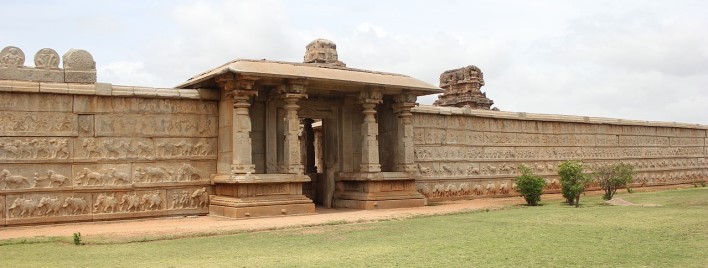
From: APRIL 20, 2017 BY MADUR: Karnataka.com
5. Relics of Ramayana
Hampi is also famous for the Hazara Ram temple. The temple has gained popularity because of the presence of historical objects and fossils that are claimed to be present at the time of Ram and Krishna’s era. The entire outer walls of the temple are carved and ornamented with the antique objects that narrate the Ramayana, a holy book that delineate the life of Lord Rama. It is claimed that the fossils and antique objects that are present in this temple are the rarest ones found in whole India. We bet did not know this fact about Hampi.
6. Naughty baby elephant
On entering the second tower on the left side in the Virupaksha Temple; one would see the temple’s main detainee, a baby elephant. If given a one-rupee coin, the elephant will collect it with his trunk and will kiss on the head as a blessing.
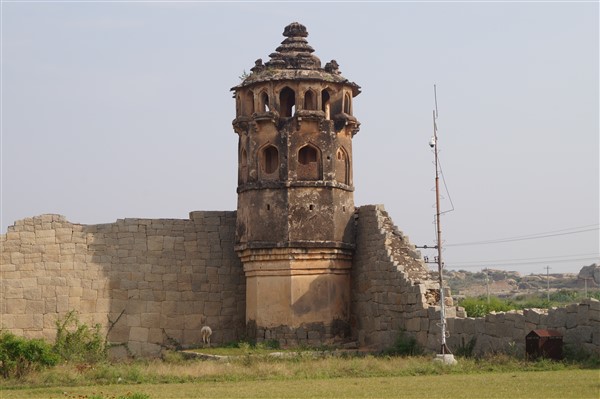
From: APRIL 20, 2017 BY MADUR: Karnataka.com
7. The inverted tower
There is a staircase behind the leading sanctum of the temple that heads towards the back exit of the temple. A dark chamber with a small opening in the wall is present before the exit on the right side. At the point when the sun beams go through the opening and fall on the western wall, the inverted main tower is visible as the shadow in the image.
8. Foodie Ganesha statue
There was a day when Ganesha’s stomach was about to explode since he stuffed a lot of his favorite meal. Tying his stomach with a snake was the last resort that Ganesha could find. As necessary, Ganesha tied a snake along his belly to escape the bursting of his stomach. This traces back the cause behind the unique design of the Ganesha’s statue in the temple. The Ganesha has 4 hands holding the pasha (noose), goad, his broken tusk and modak (sweet). This statue is made out of a single rock and is around 8 feet tall. The statue is covered with an old pavilion. Indeed, this is a less known fact about Hampi.
9. The royal enclosure
There exists an enclosure zone, where the royal group of the Vijayanagara Empire used to reside. This royal enclosure is spread over a range of 59,000 square meters. This enclosure can house around 43 houses at once. They royal families of the era used this place. The highlight of this place is the Lotus Mahal amidst the enclosure. This secluded are was built for queens and other royal ladies of the Vijayanagara Empire. Most of the parts of the enclosure are destroyed; even then the vestiges provide a great visual of the royal life of those times.

From: APRIL 20, 2017 BY MADUR: Karnataka.com
10. A long street – Hampi Bazaar
In front of the Virupaksha Temple unfolds a one-kilometre long street called the Hampi bazaar. The street is covered on both the sides with a set of old pavilions. The street makes a good place for a morning stroll with beautiful views on either side. A wooden car attired with tin sheets is in the midst of the street. During annual car festival, the tradition of pulling the car is practiced. There is a Nandi statue at the eastern end of the street, next to which lies the two storied photo gallery pavilion.
The temple town
Hampi, a temple town in northern Karnataka, was once the capital of the historical Vijayanagara Dynasty. This quaint place, lying amidst striking ruins of the past, has been receiving tourists from far off for ages. The magnificence of the ruins of temples and other structures of Vijayanagar, dating back to 1500 AD, is the main attraction of this place. According to some accounts, Hampi used to be the second largest city of the world.
Stone Chariot, Hampi There are innumerable boulders around Hampi that are easy to climb. One can get a stunning view of the ruins spread around Hampi by mounting one of the boulders. Located on the bank of the Tungabhadra River, Hampi has quite a number of tourist attractions like Virupaksha Temple, Vithala Temple and Nandi Statue. It is best to visit Hampi during the three day long Hampi festival held around October-November every year. Read more about Hampi
Yantrodharaka Hanuman Temple, Hampi – The Abode of Lord Hanuman
June 30, 2018 by madur, Karnataka.com
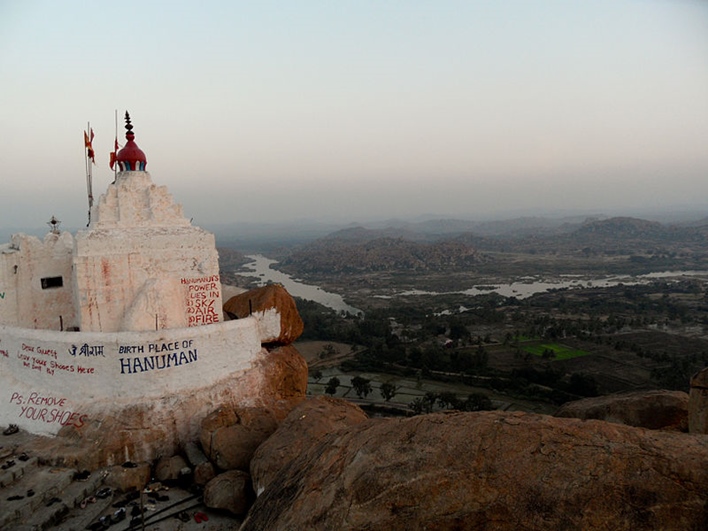
From: June 30, 2018 by madur, Karnataka.com
Dedicated to Lord Hanuman, the Yantrodharaka Hanuman Temple gets its name from the image of Hanuman placed inside an amulet. The position of Hanuman is different from any other image of Lord Hanuman that can be found in Hampi. This temple is the second most important shrine dedicated to Lord Hanuman in Hampi.
Yantrodharaka Hanuman Temple Yantrodharaka Hanuman Temple. Image courtesy Daniel Hauptstein
Quick Facts Yantrodharaka Hanuman Temple
Main Deity: Lord Hanuman
Best time to Visit: October to March
Temple Timings: Morning and evening
Entry Fee: Free
History of the Yantrodharaka Hanuman Temple
According to some legends, this temple is built on the place where Hanuman and Lord Ram met for the first time. Others believe that Sri Vyasaraja used to pray to Lord Hanuman in this place by drawing an image of Lord Hanuman on the rocks.
By the time he finished his prayers, the picture would have disappeared. When this happened for 12 days in a row, he pleaded with Lord Hanuman to appear before him. When the Lord appeared, he asked Sri Vyasaraja to constrain him in a six-sided amulet and build a temple in the area.
The Temple Architecture
The Anjaneya Temple is located on a hill on the banks of the Tungabhadra River. The inner sanctum contains an image of Lord Hanuman enclosed within a hexagonal amulet. Hanuman has been pictured in a meditative state. This is a marked deviation from other depictions of Lord Hanuman.
In Hampi, most depictions of Lord Hanuman show him standing with one hand raised and the other on his hip. It is only in this temple that Hanuman appears in a prayer position. In this image, Lord Hanuman’s crown has been formed by his tail.
12 monkeys have been carved around this amulet. They represent the 12 days Sri Vyasaraja prayed to Lord Hanuman. Each monkey holds the tail of the monkey in front of him but is facing backward. Seed syllables have also been carved around the amulet.
Other Things to See
Within the temple is another small temple devoted to Lord Ram. This lends credibility to the legend of Hanuman having met Lord Ram at this place.
Just ahead of the temple is a fig tree. At the foot of this tree are a number of snake-stones which are sued as places of snake worship.
A short climb ahead of the Temple is another small temple dedicated to an incarnation of Lord Vishnu.
How to Reach Yantrodharaka Hanuman Temple
By Air
Bellary, the closest airport to Hampi is at a distance of 64km. Taxis, buses and hired cars ply regularly between the airport and Hampi
By Rail
Hosapete is the closest railway station to Hampi. This is at a distance of 10 km and can be reached by car, taxi or bus.
By Road
Hampi is well connected by roads. You may drive down in your own car, a hired taxi or by bus.
The Jewel of Hampi- The Stone Chariot
The Jewel of Hampi- The Stone Chariot, July 9, 2017 by madur: Karnataka.com
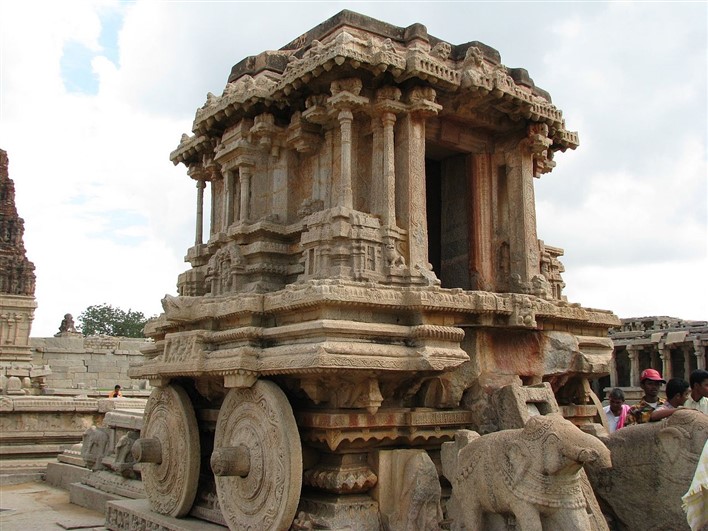
From: The Jewel of Hampi- The Stone Chariot, July 9, 2017 by madur: Karnataka.com
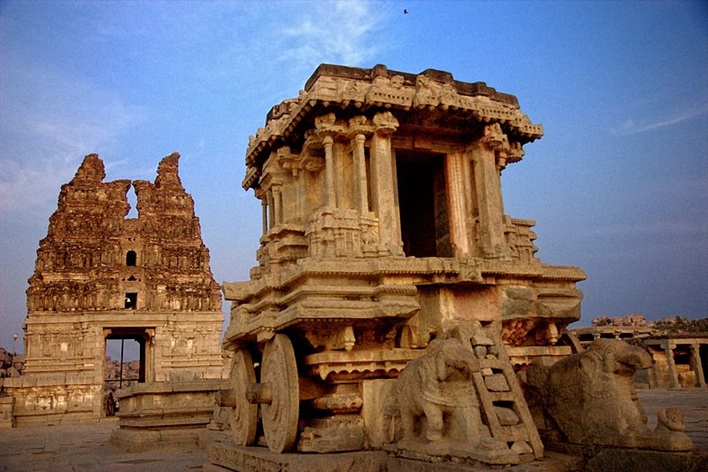
From: The Jewel of Hampi- The Stone Chariot, July 9, 2017 by madur: Karnataka.com

From: The Jewel of Hampi- The Stone Chariot, July 9, 2017 by madur: Karnataka.com
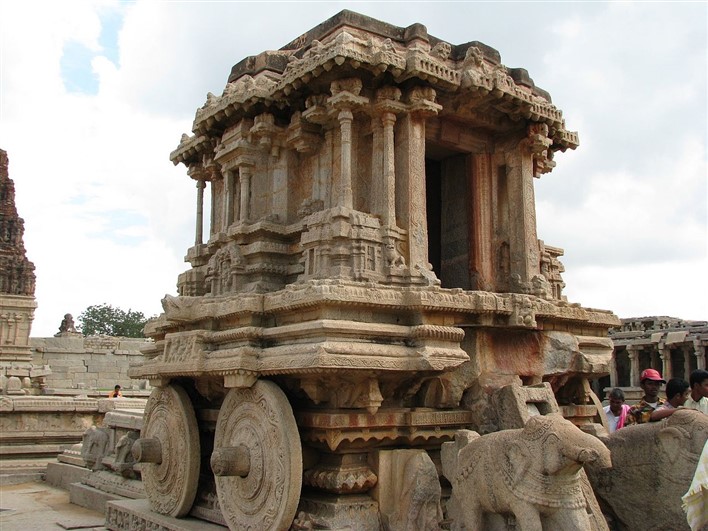
From: The Jewel of Hampi- The Stone Chariot, July 9, 2017 by madur: Karnataka.com
Every tourist place has that one spot which earns it galore and admiration. For Hampi, the small, dainty temple village set in Karnataka, it’s the iconic stone chariot. It’s the leading man in the army of exquisite beautiful sights that Hampi has to offer and depicts Karnataka tourism an icon itself.
The chariot is actually a shrine dedicated to Garuda, built inside the Vittala Temple Complex. The massive sculpture of Garuda, Lord Vishnu’s escort once was seated atop the chariot but it is empty at the present date. The Hampi Chariot has earned its name among the other three famous stone chariots in India- One in Konark, Odissa, and the other in Mahabalipuram (Tamil Nadu).
Quick Facts about the Stone Chariot
Timing: 8:30 AM to 5:00 PM on all days of the week
Entry Fee: No entry fee required
Photography: Allowed
Video camera: Allowed
Visit Duration: About 3 hours
Best time to visit: From November to February
History of the Chariot
The chariot was built by King Krishnadevaraya of the Vijayanagara Empire during the 16th century, who got fascinated with the Konark Sun temple chariot while fighting a battle in Odissa. The chariot is meant to represent the beauty and artistic perfection of the Empire. An interesting folklore emanates from the Hampi chariot as villagers believe that the world would come to a halt when the chariot moves from its place. It has come to have a sacrosanct presence and is internationally recognized as a world heritage site even by the UNESCO.
Architecture
Inspired by the Dravidian style of architecture, the chariot is a colossal structure which shows the skill of the earlier craftsmen and architects. The beauty of the chariot lies in the fact that it looks like one solid structure but in fact, has been built by slabs of granite whose linkages have been cleverly hidden with artistic designs.
The base on which the chariot rests depicts beautiful mythical battle scenes in intricate details. There were sculptures of horses where presently elephants are seated. Visitors can actually spot the hind legs and tails of the horses behind the elephants. There are also the remnants of the ladder in between the two elephants, using which priests used to climb up to the inner sanctum to pay homage to the sculpture of Garuda.
A beautiful illumination of the chariot happens in the evening from the floodlights installed in the Vittala Complex. The spectacular view of the chariot and its detailed designing in the glow of the lights from the complex makes for a mesmerizing experience.
Things to Know for Tourists
The Vittala Temple Complex is open on all days of the week from 8:30 AM to 5:00 PM.
There is no entry fee
The authorities allow for photography and videography within the temple complex.
Tourists normally spend about 3 hours at the complex.
How to Reach Hampi
By Air
Hampi doesn’t have an airport and hence visitors will have to use the Bellary Airport which is roughly 64 km from Hampi and visitor can take a vehicle to cover up the last few miles.
By Rail
The nearest railway station is Hosapete which is situated at a distance of 10km from Hampi and has a good connectivity in and around Karnataka.
By Road
Hampi has good road connectivity and people travel usually from big cities like Bangalore and Mysore to Hampi via private or public buses or by hiring cars.
Royal Enclosure – Home of Erstwhile Kings and Queens
JUNE 21, 2017 BY MADUR: Karnataka.com
The stone chariot of the Vittala Temple and the temple’s musical pillars may be the most recognizable architectural structure in Hampi but they are far from being the only ones. On the banks of the River Tungabhadra, Hampi is home to a number of Jain and Hindu temples, aqueducts and the Royal Enclosure spread over 59000 square meters. This was once upon a time, the home of the Vijayanagara King and his Queens. Today the enclosure lies largely in ruins but still speaks loudly of the life it once contained.
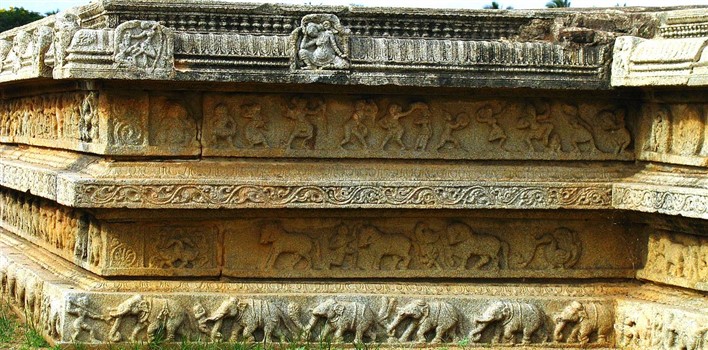
From: JUNE 21, 2017 BY MADUR: Karnataka.com
The Story of Hampi
Hampi rose into prominence in the early 14th century when the Kampili Kings rose in power. In 1327, the kingdom was attacked by Muhammad-bin-Tughluq who took two brothers, Bukka and Harihara as prisoners along with thousands of other people. These brothers tricked the Sultan into setting them free and returned to Kampili to set up a kingdom of their own with its capital at Vijayanagara. Thus the Vijayanagara Empire was founded by Harihara I and Bukka I of the Sungama dynasty in 1336. The Sungama dynasty was followed by the Saluvas and the Tuluvas each of whom added to this Vijayanagara’s architectural beauty. A number of prominent temples and architectural features of Hampi were built under the patronage of King Krishnadevaraya in the early 16th century. After his death, the Vijayanagara kingdom began its decline and the city was rediscovered only in the 1800s as Hampi.
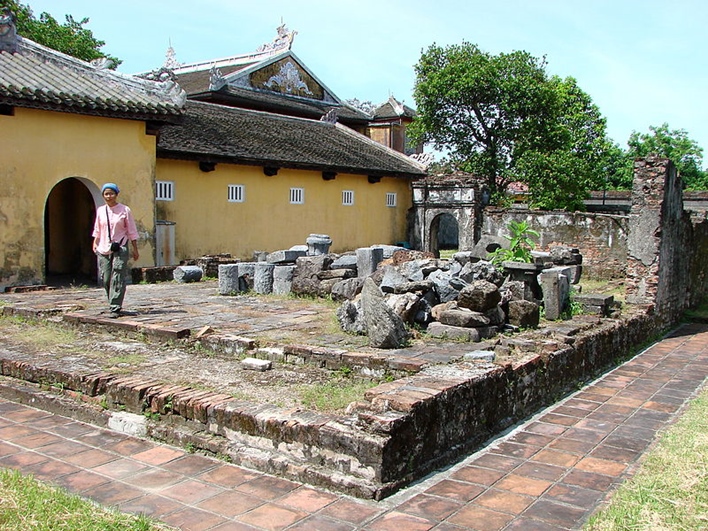
From: JUNE 21, 2017 BY MADUR: Karnataka.com
The Royal Enclosure and its Architecture
The royal enclosure in Hampi was the Vijayanagara kingdom’s seat of power. In its prime, it housed as many as 45 buildings including the durbar halls, platform, tanks, underground chambers, and temples. There are three entrances to the Royal Enclosure; two in the north and one in the west.
The architectural style of this enclosure is symbolic of the Vijayanagara style of architecture with traces of Mughal influence. As with all the other features constructed by the Vijayanagara kings, the Royal Enclosure makes ample use of granite and soapstone. All the palaces face the east or the north and were built on raised granite platforms. These platforms feature multiple tiers and are decorated with carved details of flowers, geese, demon faces, elephants and human figures. Though the palaces themselves may not stand today, ask recovered from the site suggests that they used wooden beams and rafters. Domed structures were built with a stone rubble and mortar mixture. The watch towers, elephant stables, and Lotus Mahal are examples of the Islamic influence to this style of architecture.
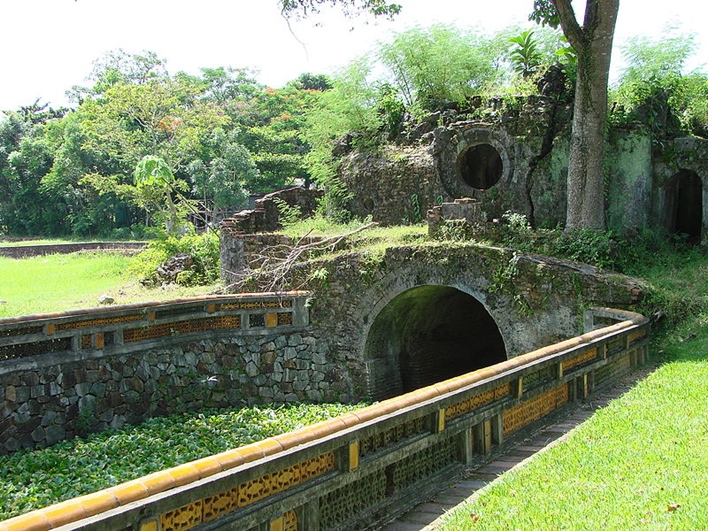
From: JUNE 21, 2017 BY MADUR: Karnataka.com
Things You Shouldn’t Miss
The Royal Enclosure of Hampi has often been compared to an open air museum. Apart from giving the visitor a glimpse into what life was like under the Vijayanagara rulers, it also showcases the architectural excellence of the era and the level of destruction the city witnessed after the decline of the Vijayanagara kings. Some of the most impressive structures here are:
The Mahanavami Dibba
This 3 tiered 8 meter high platform is the only structure that still stands as it did centuries ago. It stands in the northeast section of the enclosure and has a flight of stairs leading up on the east, west and southern face. Each tier of the platform features intricately sculpted moldings that depict the everyday life of that time. As the name suggests, the platform was used during the Navami celebrations and remains of pillar bases indicate that a pavilion once stood in the center.
The Aqueduct
Within the royal enclosure the aqueduct networks of stone ‘pipes’ connect over 20 wells and ponds. A large section of the aqueduct has been restored and some sections deliver water even today. Bukka’s Aqueduct towards the north of the river is the most significant amongst them.
Stepped Tank
Discovered in 1985, the stepped tank is considered one of the most well-preserved structures in the Royal Enclosure. This is a 5 tiered tank that covers an area of 22 square meters and has a depth of 7 meters. Two other significant bathing pavilions in the Royal Enclosure are the Octagonal Bath and the Queen’s bath.

From: JUNE 21, 2017 BY MADUR: Karnataka.com
Hazara Rama Temple
This is the only temple in the Royal Enclosure. As the name suggests, the temple is dedicated to Lord Rama. Bas relics on the walls of the temple depict the Ramayana and are considered the most extensive relics from all over India.
The Underground Chamber
This chamber lies between the Durbar Hall and the Stepped Tank ad features independent entry and exit routes. It is believed that the Vijayanagara rulers held important discussions with their trusted aides in this chamber.
Durbar Hall
This is also known as the King’s audience hall or the 100 pillared halls. Remnants of a stone staircase suggest that this might have been a two storied structure. It is believed to have been made of wood and destroyed in a fire in 1565 AD.
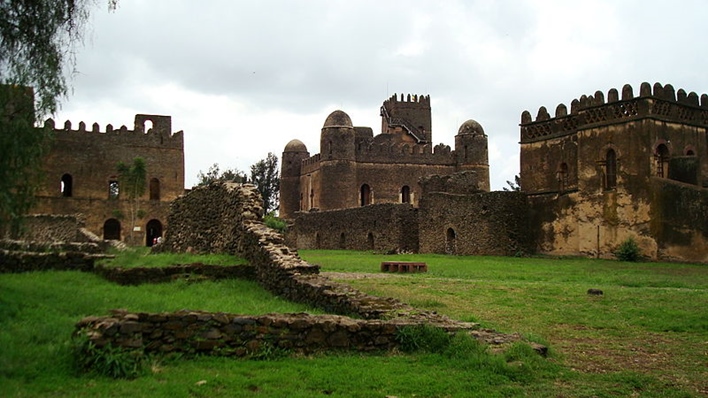
From: JUNE 21, 2017 BY MADUR: Karnataka.com
Present Condition of the Royal Enclosure
Today, only the stone platforms remain to mark where palaces and building once stood. Since many structures were made of wood, this area seems to have been easier to destroy than other parts of Hampi with complete stone structures. Though it may look like an empty area at first glance, a closer look will bring out many interesting relics and details.
How to Reach the Royal Enclosure
One must keep aside plenty of time when visiting the Royal enclosure. Hiring a cycle within the enclosure can save lots of walking time and make the experience more enjoyable. The enclosure is open 7 days of the week from 9am to 5.30 pm. Visitors are recommended to wear comfortable footwear and carry plenty of drinking water.
By Air
At a distance of 64km, Ballari is the closest airport to Hampi. From the airport, taxis, buses and hired cars ply regularly to Hampi.
By Rail
The closest railway station to the Royal enclosure is situated at Hosapete. This is 10 kms for Hampi and can be reached by buses or cars.
By Road
There are a number of buses that operate regularly between Hampi and the other cities across Karnataka. Private taxis are also available on hire from Major cities like Mysore and Bengaluru.
Lotus Mahal in Hampi – Of Grandeur and History
APRIL 25, 2017 BY MADUR: Karnataka.com
A tour to Hampi is incomplete without visiting Lotus Mahal. It is one of the fine architectural designed palaces that are uniquely identified by its lotus look like structure. This glorious building is within the Zenana Enclosure, a segregated area that is used by the royal women of Vijayanagara Dynasty.
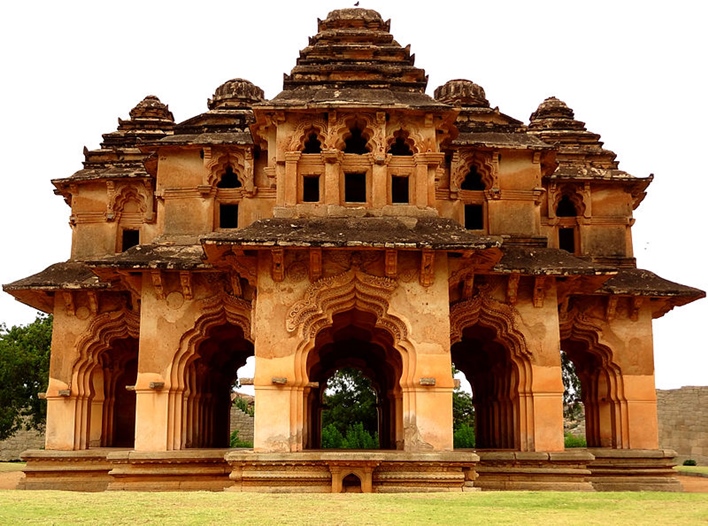
From: APRIL 25, 2017 BY MADUR: Karnataka.com
The Lotus Mahal is otherwise called the Kamal Mahal or Chitragani Mahal. It’s remarkable and unmistakable design is the main highlight of the palace. It is one of only a handful few astonishing building in Hampi that had not been damaged or destroyed amid the attack on the city.
Quick Facts about Lotus Mahal
Timing: Open on all days of the week from 8:00 am to 6:00 pm
Entry fee for adults: INR. 10 for Indians and INR 250 for foreign tourists
Entry fee for children: Entry is free for children under 15 years
Photography: Allowed (no extra charges levied)
Visit duration: 2 hours approximately
Best time to visit: From November to February
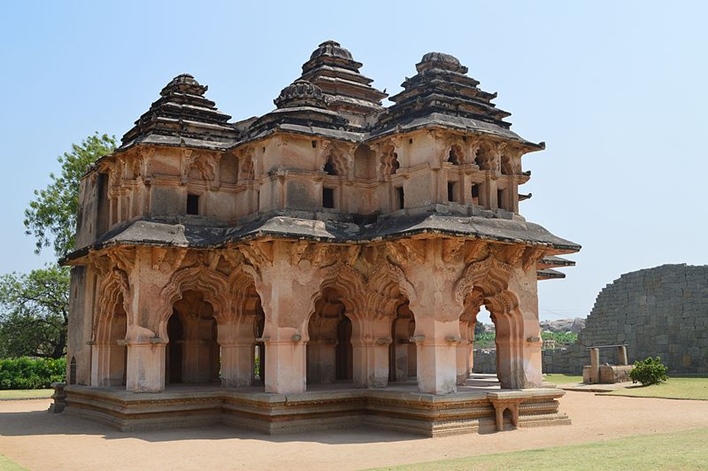
From: APRIL 25, 2017 BY MADUR: Karnataka.com
Architecture of the Lotus Mahal, Hampi
As the name given to the palace is because of the shape it resembles. The balcony and the passages covered with a dome that looks like an opened lotus bud. The central dome is also carved as a lotus bud. The curves of the palace are given an Islamic touch while the multi-layered roof design is moreover related to Indo style of buildings. The style and designs is an inquisitive blend of Islamic and Indian way of architecture.
The palace is a two-storied building, well-structured symmetrically. It is surrounded by a rectangular wall and four towers. These towers are also in pyramidal shape giving a lotus-like structure visual. Around 24 pillars are present to support the arched windows and balcony of the palace. The walls and pillars are carved beautifully with patterns like sea creatures and birds.
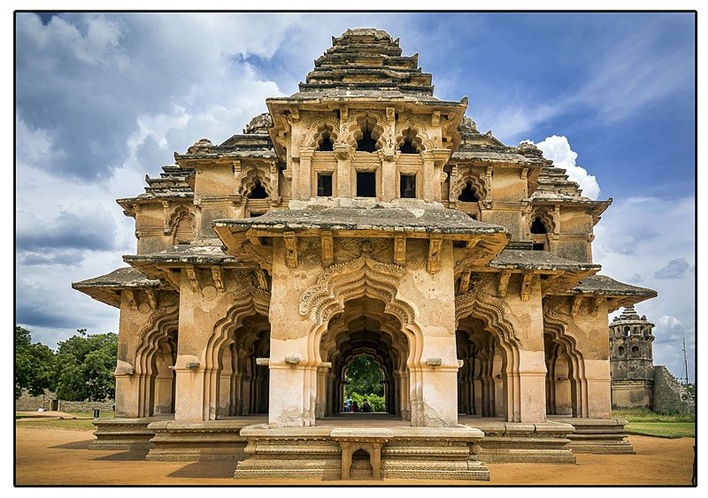
From: APRIL 25, 2017 BY MADUR: Karnataka.com
The surrounding area of the palace is covered with many shady trees providing a cool ambiance to the palace. At the point when the Lotus Mahal is lit up during the evening, visitors witness a fantastic view. It is a standout venue in entire Hampi to take photographs. Lotus Mahal should be a sure set destination in the list while visiting Hampi. It will stun you to perceive how best in class, Indian architecture and workers were ages back.
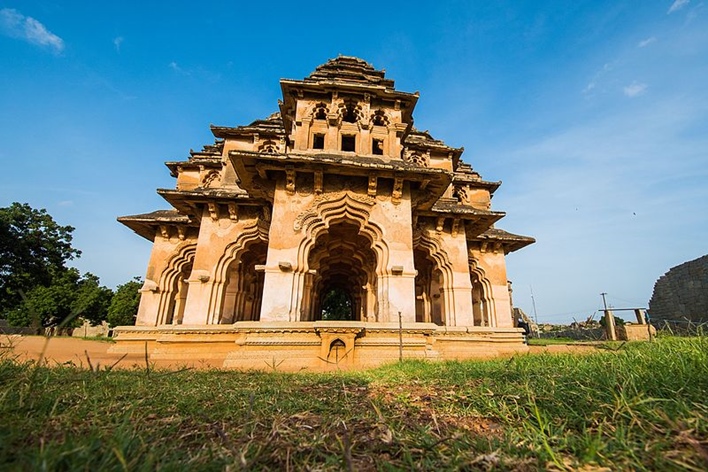
From: APRIL 25, 2017 BY MADUR: Karnataka.com
History of Lotus Mahal, Hampi
The Lotus Mahal was a part of Zenana enclosure, a place where royal families of Vijayanagara Empire resided. Lotus Mahal designed as a palace for royal ladies of those times to mingle around and enjoy recreational activities. The Mahal also served as a meeting point for the king and his ministers. This place is also referred to as a council chamber in the maps found.
It is said that the Queen of Krishna Deva Raya used to spend her most of the time seeking pleasure and peace in the palace. The palace also served as a meeting point for the king and his ministers. Kaml Mahl is also referred to as a council chamber in the maps found in 18th century. Kamal Mahal and Chitrangini Mahal are the other names by which it was known earlier. Several musical concerts and other recreation activities were held at this place.
Sasivekalu Ganesha Temple in Hampi
APRIL 24, 2017 BY MADUR: Karnataka.com
Hampi, a UNESCO world heritage site, is known for its magnificent temples and one such fine specimen is Sasivekalu Ganesha temple. Sasivekalu Ganesha Temple is a huge statue of Lord Ganesha, carved out of a single block of rock. It is one of the major landmarks in Hampi. Sasivekalu Ganesha is about 8 feet (2.5 metres) tall.

From: APRIL 24, 2017 BY MADUR: Karnataka.com
History of Sasivekalu Ganesha Temple
According to the Hindu mythology, Lord Ganesha is known for his love for food. Once Ganesha consumed a lot of food, due to which his stomach was on the verge of bursting. Finding no other option to stop his stomach from exploding, Ganesha caught hold of a snake and tied it around his stomach in order to prevent it from bursting open. This is the mythological incidence behind the existence of the snake tied around the Ganesha’s stomach, which is visible on the statue.
The inscription on the statue is as old as 1500 AD and says that this statue was erected in memory of the king Narasimha II, of the Vijayanagar Empire. This temple and the statue is indeed one of the finest specimens of Indian sculptures.
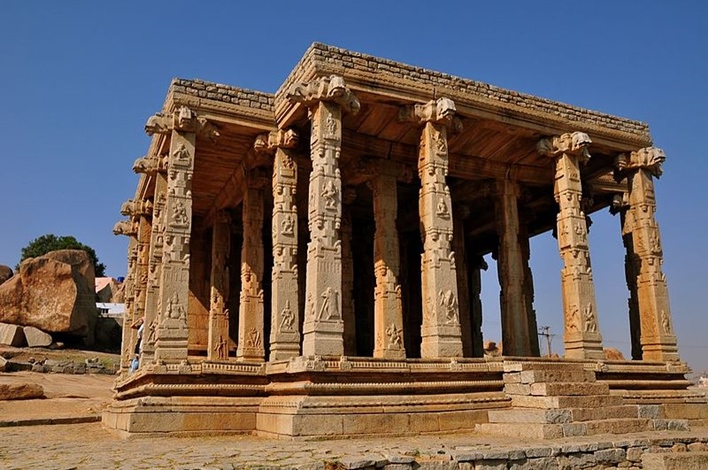
From: APRIL 24, 2017 BY MADUR: Karnataka.com
Architecture of Sasivekalu Ganesha Temple
The Ganesha is seen in a half-lotus position with four arms. The right and left hand at the upper side holds a goad and a broken tusk. The top right hand of the statue holds a sweet (modak) the left hand is portrayed with a noose. A large mandapa is covering the statue at the top with a rough wall covering pillars around it. The archaeology department has installed a huge sitemap consisting of whereabouts of the place and history of the statue.
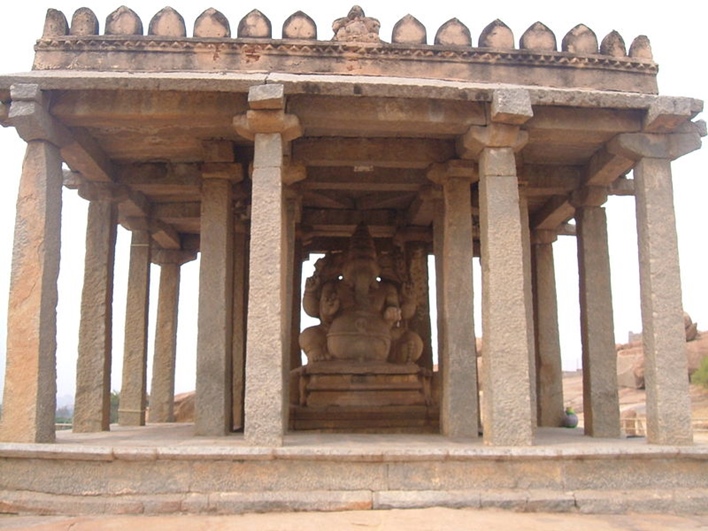
From: APRIL 24, 2017 BY MADUR: Karnataka.com
How to Reach Sasivekalu Ganesha Temple
Sasivekalu Ganesha Temple is situated in the town of Hampi. Any local transport in the city can be used to reach the temple. You can reach Hampi by any of the following conveyance.
By Air
Hampi does not have an airport but can be reached through the nearby airports. Bellary is the nearest airport, about 615 kms from Hampi. There are a number of buses and taxis available from Bellary to Hampi. Apart from Bellary, Bangalore airport can also be accessed to reach Hampi; it is 353km from Hampi. One can hire a cab or taxi from the airport to reach the beautiful Hampi village.
By Rail
The nearest railway station is located at Hospet which is about 13km from Hampi. Hampi does not have a railway station but can be reached via Hospet rail route. There are many buses and taxis which connect Hampi and Hospet, either of the ways can be opted to reach Hampi.
By Road
Hampi is well connected with major cities and towns of Karnataka by bus service. A number of private and tourist buses run regularly from neighbouring cities to Hampi. Road route is the best one. A direct drive to Hampi through NH 13 route from Bangalore (345 km) and Hubli (165 km) is the other option out of the lot.
Achyuta Raya Temple, Hampi
APRIL 24, 2017 BY MADUR: Karnataka.com
The Achyuta Raya Temple is in Hampi. It was built in 1534 AD. It is one of the major, splendid and awe-inspiring temples of Hampi located between the Matanga hills and Gandhamadana. This magnificent temple depicts Vijayanagara architecture style of temples in its best and most improved form. This was among the last dazzling temples that were constructed in the celebrated city of Hampi prior to the decline of the Vijayanagara Empire.

From: APRIL 24, 2017 BY MADUR: Karnataka.com
Quick Facts About Achyuta Raya Temple, Hampi
Timing: From 5:30 AM – 1:00 PM and from 5:30 PM – 9:00 PM on all days of the week
Entry Fee: No entry fee required
Photography: Allowed
Visit Duration: About 2 hours
Unfortunately, this elegant and striking temple is in ruins as a consequence of the attacks by the monarchs of the Bahamani kingdom. It is greatly affected by the forces of nature over several centuries.
The location of the temple is secluded and off the more travelled path, the temple is much less crowded as compared to many other tourist attractions in Hampi. It is good news for the people who like quite tours because this place is off location and its hidden nature makes it less crowded. The best time to visit the temple is from November to February.
The main idol worshiped in the Achyuta Raya Temple is Lord Tiruvengalanatha which is another form of Vishnu.
The towers, pillars, and walls have exquisite carvings and ornamentation. Major parts of the temple are in a damaged condition. Although it is in ruins, the temple does not fail in grandiosity and its magnificence even today.
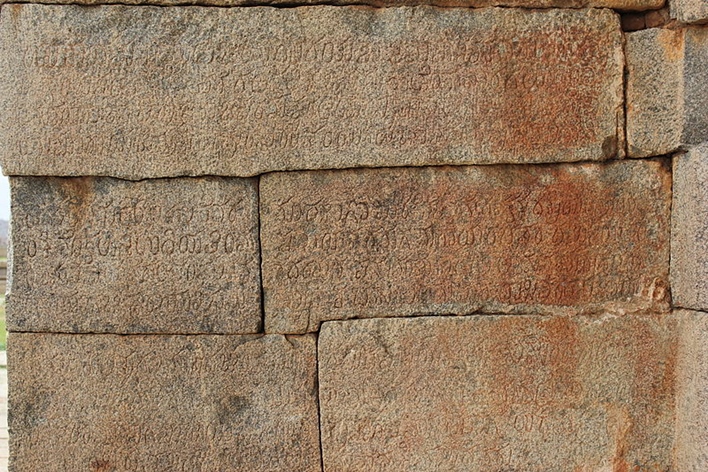
From: APRIL 24, 2017 BY MADUR: Karnataka.com
History of Achyuta Raya Temple, Hampi
The Achyuta Raya temple got built during the rule of Achyuta Deva Raya, who was one of the emperors of the Vijayanagara Empire. He came to power by succeeding his elder brother Krishna Deva Raya in the year 1529.
The stunning and heavenly temple is devoted to Lord Tiruvengalanatha; he is a configuration of Lord Vishnu. Thus, this temple was initially known as Tiruvengalanatha Temple. However, later on, it came to be called after the king in whose reign it was built. Hence, it became widely known as the Achyuta Raya temple.
Architecture of Achyuta Raya Temple
The principal shrine of the temple is located in the centre of a pair of rectangular concentric enclosures. There are pillared verandas on the interior flanks of the two courtyard walls. The outer walkways are in a state of decay, collapse, and disintegration. The temple is distinctly visible from the top of the Matanga Hill. It is at the end of the abandoned Courtesan Street.
On entering the inner court one can spot a chamber that is facing the porch leading to the central hall. There is a small shrine chamber which once sanctified an image of Garuda.
The accessible hall has few extremely lauded sculpted pillars in Hampi. The carvings are done on monolithic blocks of rocks. The statues and sculptures on the pillars reveal themes like lord Vishnu blessing an elephant, lord Krishna practising his flute while the calves are watching this scene with interest and infant Krishna dancing with a snake and holding it by the tail.
There is a Mandapa which is a marriage hall of the Gods and the Goddesses for the yearly nuptials.
How to Reach Achyuta Raya Temple
The temple is situated between the Gandhamadana and Matanga hills. There are two main routes to reach the temple. One is from Kodandarama Temple passing through the Courtesan Street and leading to the principal minarets of the Achyuta Raya Temple.
The other course to the temple is by climbing the stairs near the Nandi or Monolithic Bull situated at the eastern corner of Hampi Bazaar. The second one is the easier and the more convenient one.
By Air
Hampi does not have any airport of its own. The nearest one is the Bellary airport. Tourists can take a flight to Bellary and then can use local means of transport like cabs to reach Hampi. The total distance between Bellary and Hampi is 64km.
By Rail
Hampi does not have any railway station of its own. The one from Hampi is Hospet which is at a distance of about 13 km. Tourists can hire a taxi to Hampi from Hospet. The distance from Bangalore to Hampi is 288kms.
By Road
Hampi has a good road network. There are numerous buses that connect Hampi to a number of major and important towns in Karnataka. The tourists also have the option of hiring private cars or cabs. Travellers can reach Hampi by bus. AC and Volvo buses are available.
Dasara Dibba – A Wonderful Stone Platform
PRIL 24, 2017 BY MADUR: Karnataka.com
Dasara Dibba or the Mahanavami Dibba is a beautiful stone platform located within the Royal Enclosure of Hampi. It was built during the Vijayanagara period by King Krishnadevaraya to commemorate his victory over Udaygiri. It was here where the King of Vijayanagar used to celebrate the festival of Dasara (Dussehra).
However, The Dasara Dibba is in a ruined state now with damaged carvings on the side of the platform. UNESCO and the Government have taken proper steps in preserving the heritage for future generations.
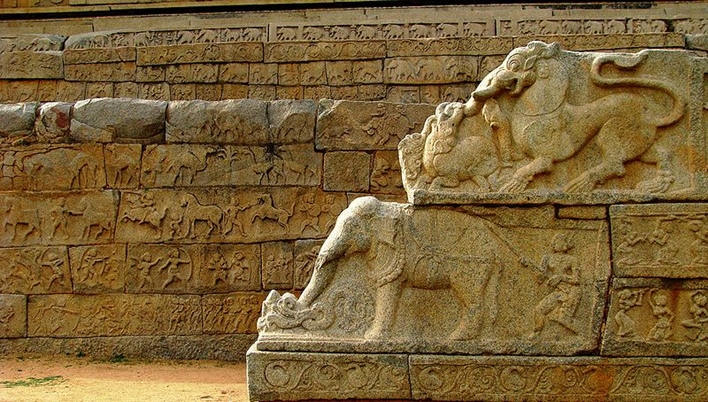
From: PRIL 24, 2017 BY MADUR: Karnataka.com
History and Legends
King Krishnadevaraya constructed this in 1513 AD in commemoration on the victory over Udaygiri (now in Orissa). According to historians, the Sagamas were the first ruling dynasty of the Vijayanagara kingdom in the 14th century.
However, Hampi reached its zenith of glory under Krishandeva Raya under whom, Hampi, the city of Victory came into full power. Hampi was destroyed in 1565 by the Deccan Sultanates.
The king watched the army march-pasts, bow and arrow competitions, war games such as sword fighting competition, wrestling, aquatic sports, musical performances of the royal animals and the hugely significant Navaratri celebrations from the raised structure of the grand platform of the Dasara Dibba.
Navaratri was celebrated for consecutive nine days according to the tradition and the tenth-day celebration was known as “Vijaya Dasami”.

From: PRIL 24, 2017 BY MADUR: Karnataka.com
Dasara Dibba – Architecture and Sculpture
The 12 meters high Dasara Dibba consist of a massive square granite faced base in three diminishing tiers, the lowest being 40 metre square and the topmost 24 metre square. The structure faces north. The stone stairs are little tough for climbing for elderly persons and kids as it is quite high to ascend.
The top can be reached by a couple of cases having carvings of elephants, horses, and others on the front while the back portion has twin staircase. This unique monument is one of the highest spots within this zone. The entry point for King to this point is different from that of the commoners. The walls are covered with auspicious carvings of horses, elephants, warriors, caravans, hunting games scenes, dancers, musicians and many other royal cultural scenes of the by-gone culture.
On the east side of the platform, is a chamber filled with animal and clown carvings narrating the stories of when the Chinese embassy used to visit the King Krishnadevaraya for business purpose and the Arab emirates came for horses and exotic animals trading.

From: PRIL 24, 2017 BY MADUR: Karnataka.com
The entry point for King to this point is different from that of the commoners. The walls are covered with auspicious carvings of horses, elephants, warriors, caravans, hunting games scenes, dancers, musicians and many other royal cultural scenes of the by-gone culture.
On the east side of the platform, is a chamber filled with animal and clown carvings narrating the stories of when the Chinese embassy used to visit the King Krishnadevaraya for business purpose and the Arab emirates came for horses and exotic animals trading.
On the east side of the platform, is a chamber filled with animal and clown carvings narrating the stories of when the Chinese embassy used to visit the King Krishnadevaraya for business purpose and the Arab emirates came for horses and exotic animals trading.
Entry to the Dasara Dibba is free and can be visited any time from sunrise to sunset, preferably during mornings or evenings as there is no shade.
Virupaksha Temple: Of History
APRIL 22, 2017 BY RAGGI MUDDE: Karnataka.com
The Virupaksha Temple in Hampi is dedicated to lord Shiva. The distance from Bangalore to Hampi is about 350 km. Hampi is a temple town in South India and is acknowledged as one of the World Heritage Sites of UNESCO. Virupaksha Temple is dedicated to lord Shiva. This temple was constructed in Lakkana Dandesha’s assistance who was a commander under King Deva Raya II.
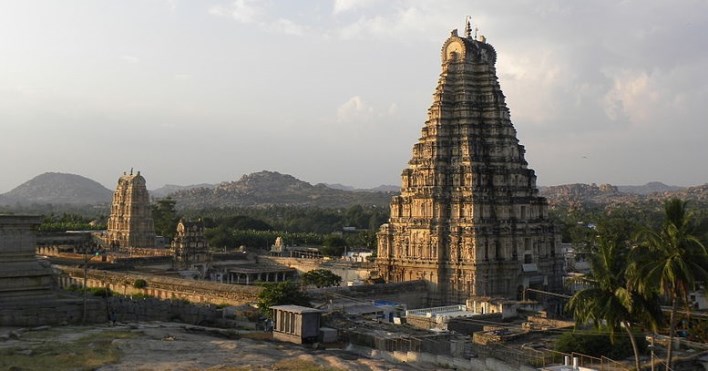
From: APRIL 22, 2017 BY RAGGI MUDDE: Karnataka.com
Hampi is on the embankment of River Tungabhadra. The predominant centre of pilgrimage in Hampi is this esteemed temple. It is the holiest and sacred retreat.
The Virupaksha temple has survived through the years and never ceases to prosper. It is still pristine amidst the ruins that surround it. It attracts large groups of people in the month of December. The yearly chariot festival is conducted in the month of February.
History of Virupaksha Temple
The Virupaksha temple’s chronicle is unremitting from around the seventh century. Virupaksha-Pampa retreat was existent since a long time here. There are several inscriptions about Lord Shiva which were engraved in the 9th century.
It started off as a little shrine and later developed into a huge complex during the Vijayanagara rule. There is evidence that indicates additions were made to Virupaksha temple during the later years of the Hoysala and Chalukyan sovereignty.
Native art, craft, and culture flourished during the fourteenth century during the reign of the dynasty. But these beautiful architectures and creations were destroyed when the Vijayanagara rulers were crushed by Muslim intruders.
The devotional group of Pampa and Virupaksha did not come to an end with the devastation of Hampi in 1565. The temple is worshiped even today and has persisted all over the years. There were extensive renovations done in the early 19th century that include the addition of towers and ceiling paintings.
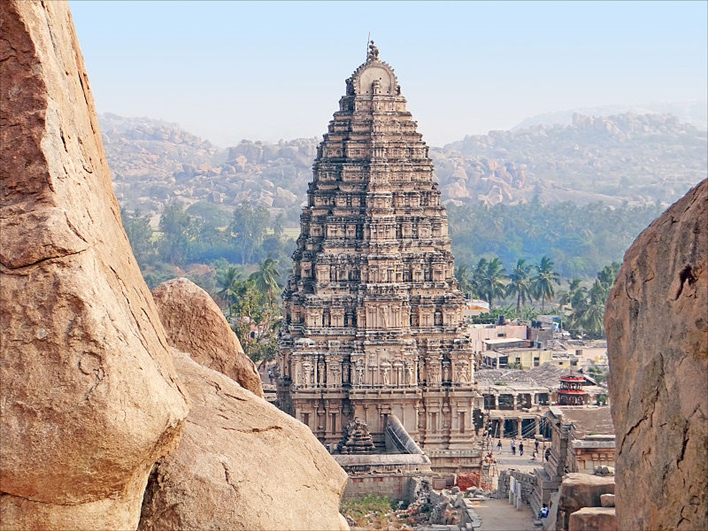
From: APRIL 22, 2017 BY RAGGI MUDDE: Karnataka.com
Virupaksha Temple Architecture
The temple has a shrine or the holy place of worship, a hall with a number of pillars and 3 antechambers. There are courtyards, a pillared monastery, few small shrines; and entrance ways surrounding the temple.
Among all the gateways, the eastern gateway is the greatest. It is nine-tiered and 50 meters in length. It is well built and has some previous structures. The framework is of brick and includes a gravel base giving way to the court outside. This court contains various sub-sanctums. The inner eastern gopuram is graced with three storeys while the northern gopuram has five storeys.
The Kanakagiri gopuram towards the north takes the tourists to a little enclosure with supplementary sanctums.
A renowned Vijayanagara King, Krishnadevaraya was a contributor of the temple. It is believed that the main pillared hall which is the most adorned structure of this temple is his addition. There is a stone slab beside the hall which has inscriptions that explain his offerings for the temple.
Surrounding the Virupaksha temple are plenty of dilapidated mandapams. There was an ancient shopping centre interlined with mandapams in front of this temple. The ruins of it stand today.

From: APRIL 22, 2017 BY RAGGI MUDDE: Karnataka.com
How to Reach Virupaksha Temple
By Air
The closest international airport from Hampi is Bellary, 350 kms away. Tourists can take a cab from Bellary to Hampi
By Rail
The nearest railway station is Hospet at about 13 km away. Hospet is amply connected to the major cities like Bellary and Bangalore. Tourists usually hire a cab from Hospet to reach Hampi. The distance from Bangalore to Hampi is a distance of 288km.
By Road
Tourists can go to Hampi by bus from places like Bellary, Hospet, and Bangalore. Volvo and AC buses are available for the passengers. Travelers can avail cabs as well.
Saraswati Temple, Hampi: An Erstwhile Glory
APRIL 22, 2017 BY RAGGI MUDDE: Karnataka.com
The Saraswati Temple is situated in the district of Bellary in Hampi. Hampi is at the heart of the city Vijayanagara, which is in a dilapidated state. Hampi is a hugely renowned site, and it is registered as a World Heritage Site by the UNESCO.
The temple is mostly in ruins now but has its old world charm. The shrine, sanctum, canopy and the pavilions are better in condition than the rest of the structure. Beautiful sculptures are still found on the pillars. The crawling baby Krishna’s carving is seen on the tower of the temple. The temple is devoted to goddess Saraswati who is the goddess of intelligence, understanding, knowledge and wisdom.
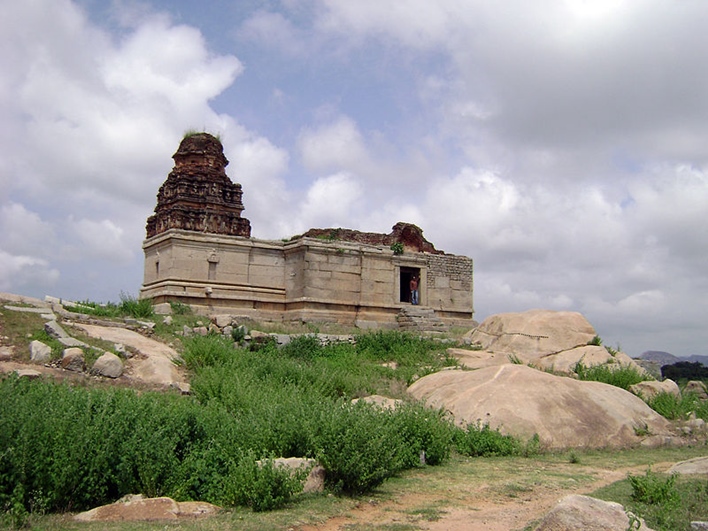
From: APRIL 22, 2017 BY RAGGI MUDDE: Karnataka.com
The Hampi ruins are sprawled in its nature and hence taking a map of the area is always beneficial. Carrying a map helps in better chalking out of the local itinerary. It is difficult to cover the entire sites of Hampi in a few days stay. There are detailed sitemaps that are displayed by the Archaeological Survey of India near the monuments in Hampi.
Saraswati Temple Architecture
This temple was built during the 13th century in Vijayanagar style and is located nearby an octagonal bath in the midst of the ruins. If the tourists are inquisitive enough then they might take a closer look at the pillars which expose plasterwork on their stone pillars with some remains of stucco images. The art and architecture of the temple can be well understood if the visitor can walk towards the path between the canal and the temple.
Goddess Saraswati is idolized and worshiped as the goddess of wisdom, knowledge and literary aspects in the Indian mythology. She has four hands, each of which holds different things. One hand has a book that represents the Vedas; one has prayer beads of pearl that signify spirituality; one holds a pot containing holy water and another one has a musical instrument Veena epitomizing fine art.
There is an enthralling rock near the temple having an image of the goddess carved on it. Around this rock, there is a shrine which is painted with beautiful bright colours. This gives an indication that the temple was built to honour the goddess. Glimpses of the history of Hampi can be known if a visitor travels to the Saraswati temple.

From: APRIL 22, 2017 BY RAGGI MUDDE: Karnataka.com
How to Reach Saraswati Temple, Hampi
By Air
The nearest international airport to reach Hampi is Bellary which is 350 kms away. Tourists can reach Hampi very comfortably by taking a taxi or cab from Bellary.
By Rail
The nearest railway station from Hampi is Hospet at a distance of around 13 km. Hospet is well connected to most major cities like Bangalore and Bellary. Tourists may hire a cab to reach Hampi from Hospet.
By Bus
Travelers can reach Hampi by bus and cabs from major cities like Bangalore, Bellary, and Mangalore
Laidback glory
India Today December 19, 2008
The ruins of the glorious Vijayanagar Dynasty are now heritage spots and quaint trails. Hemakuta Hill holds breathtaking sunrises and sunsets. Hampi is also the backpacker’s delight. The openair restaurant Under the Mango Tree is aptly located under a mango tree. For souvenirs, there’s the quaint but charming town of Anegundi.